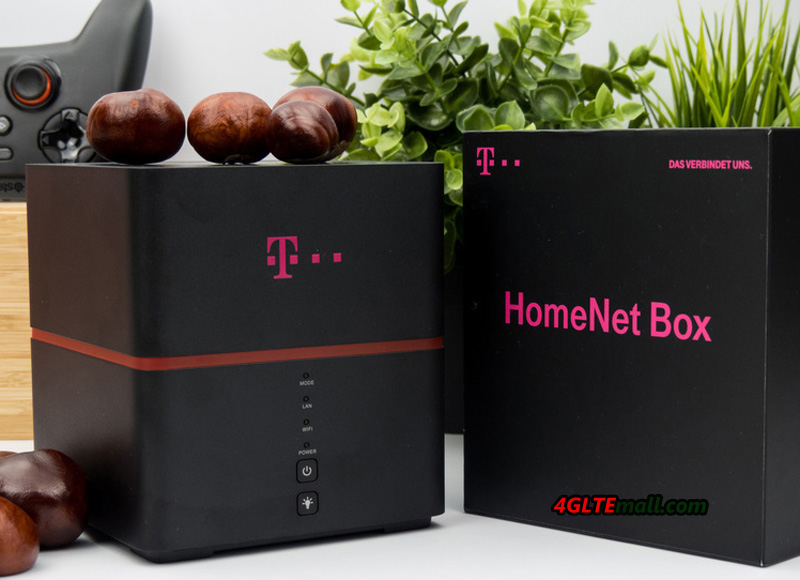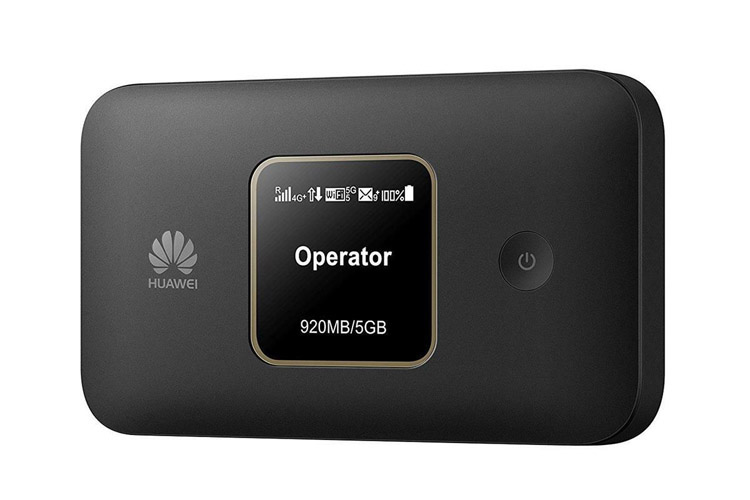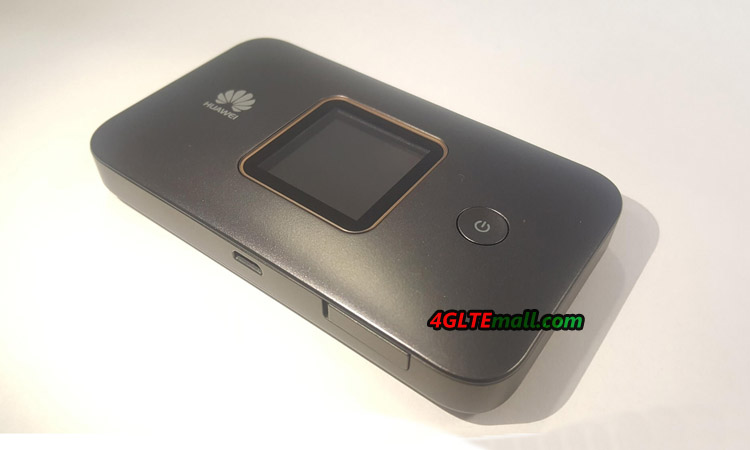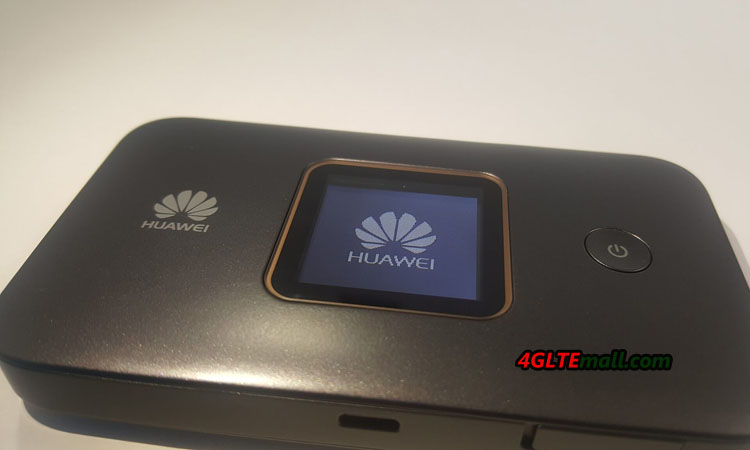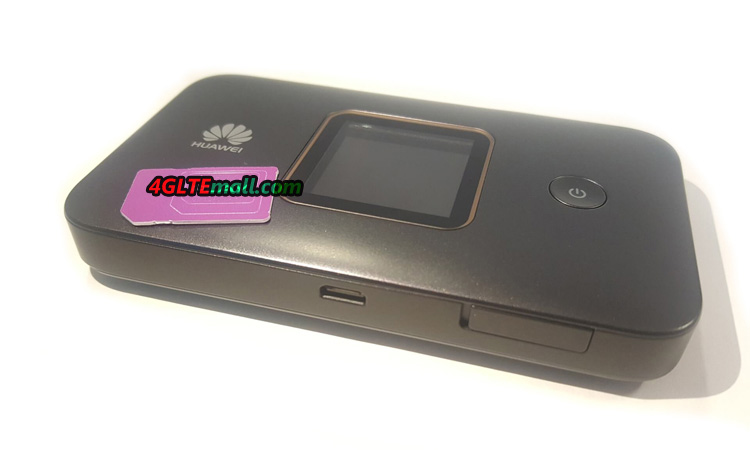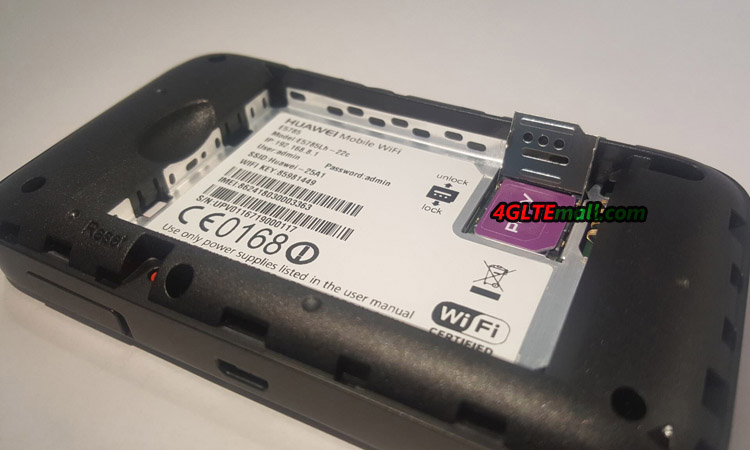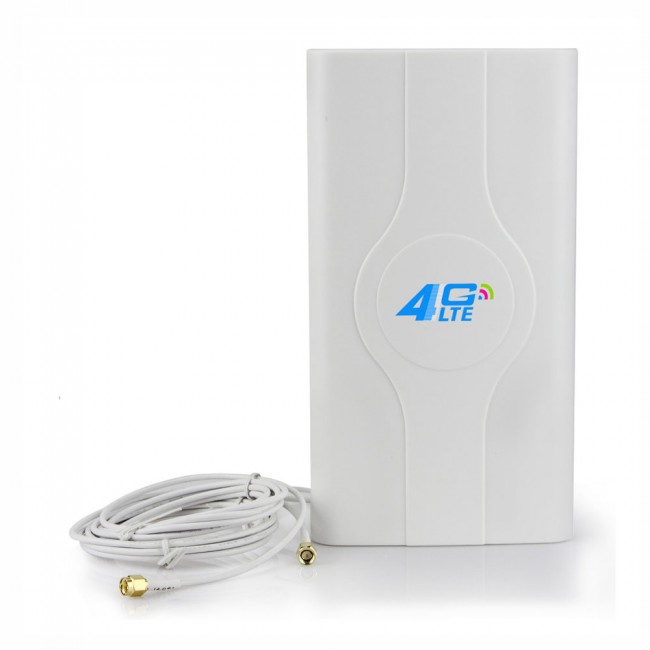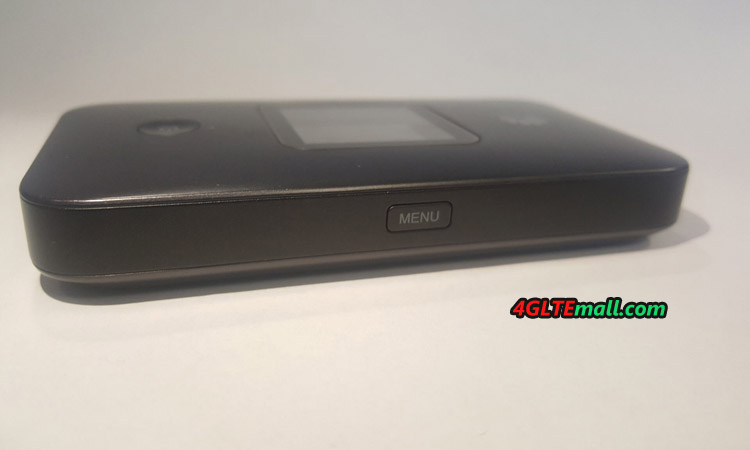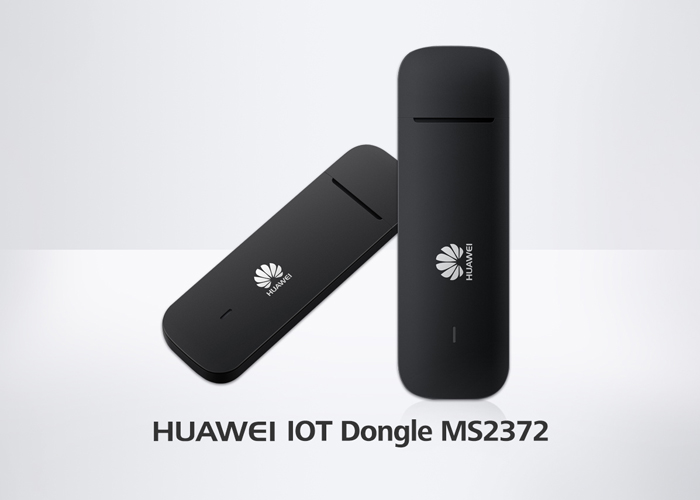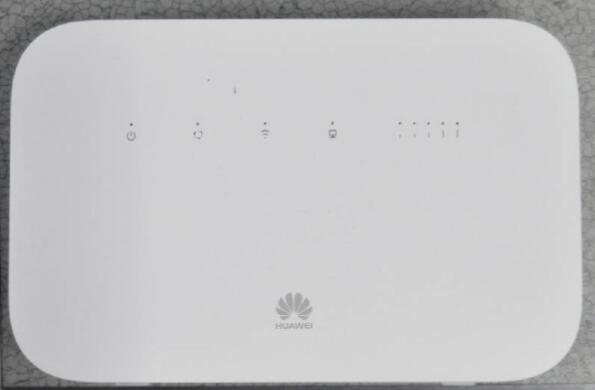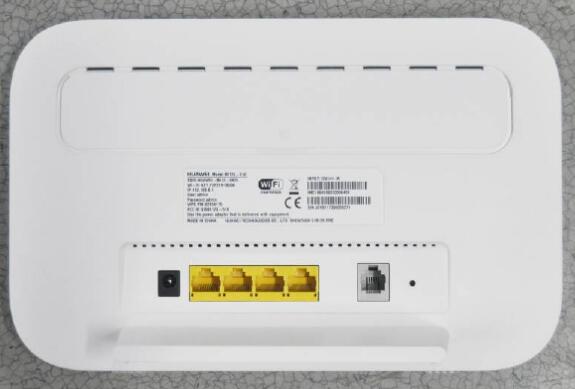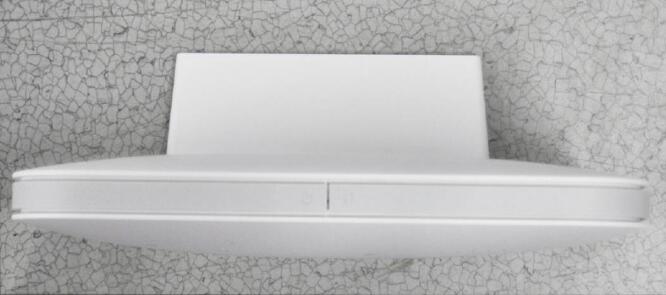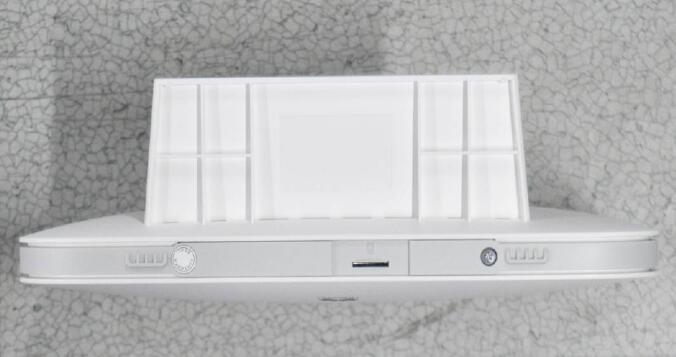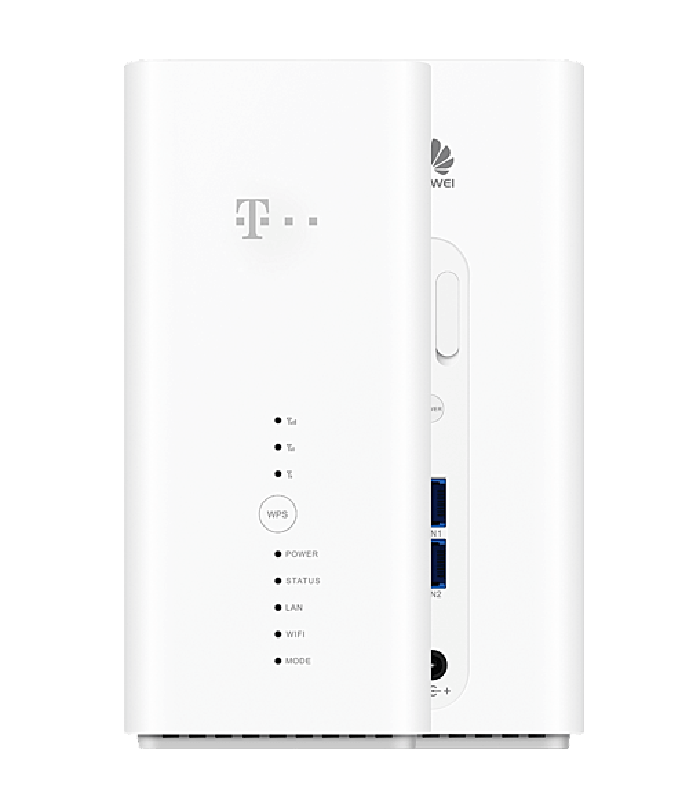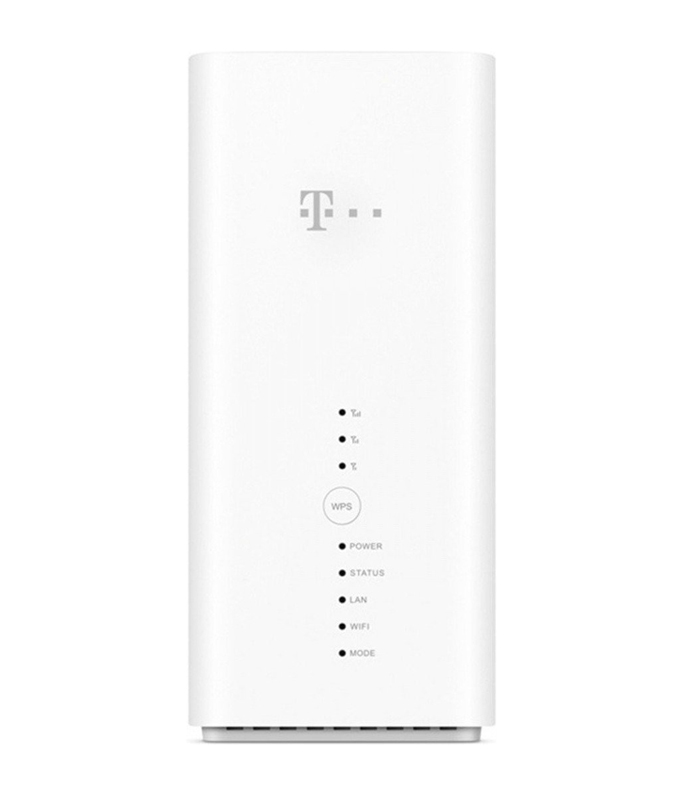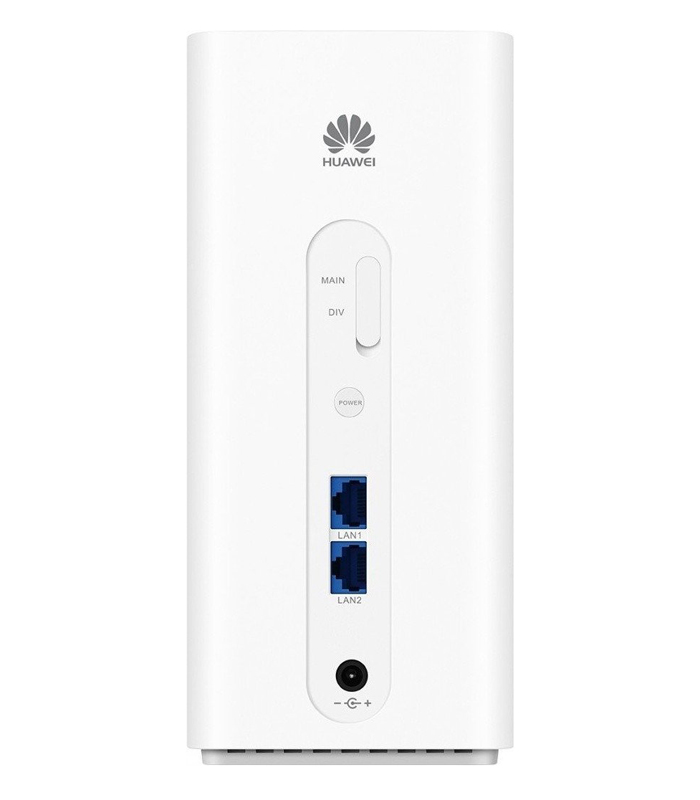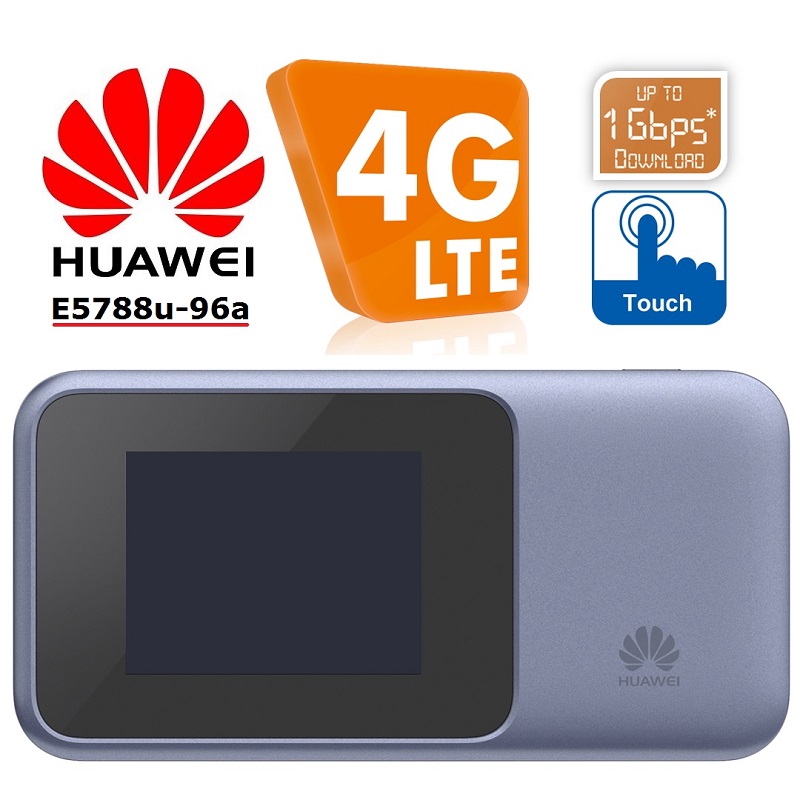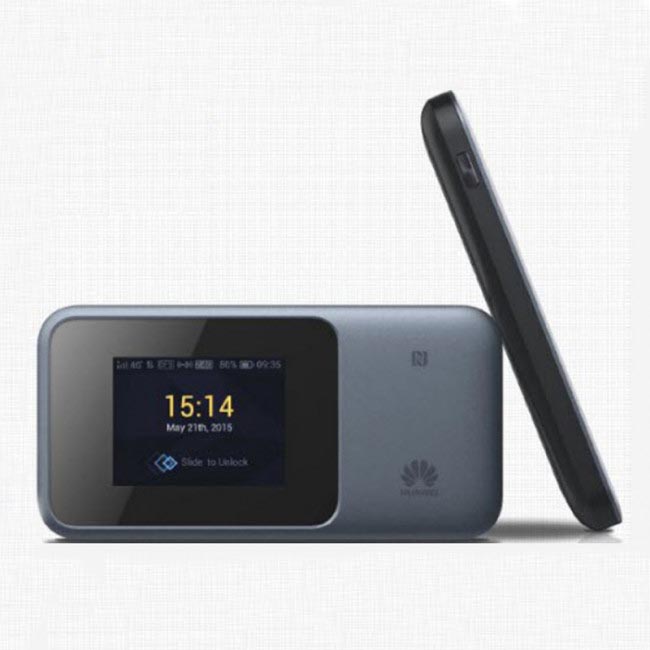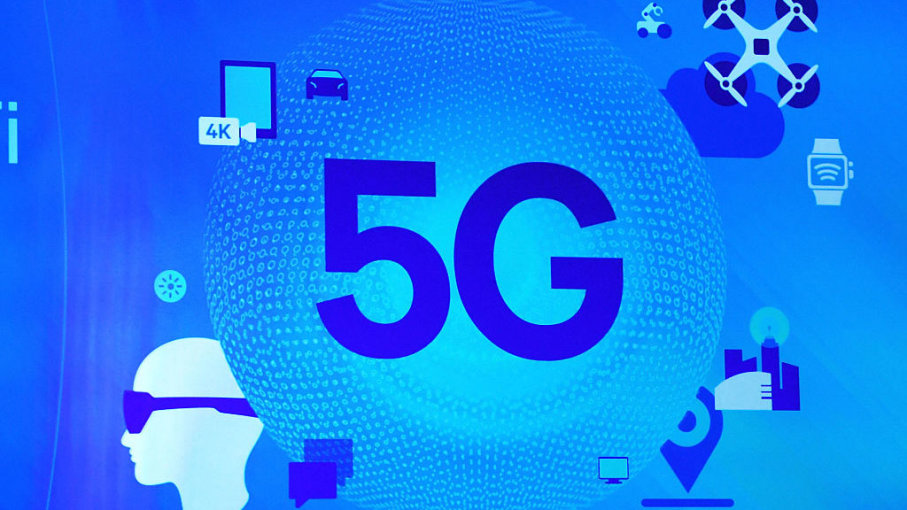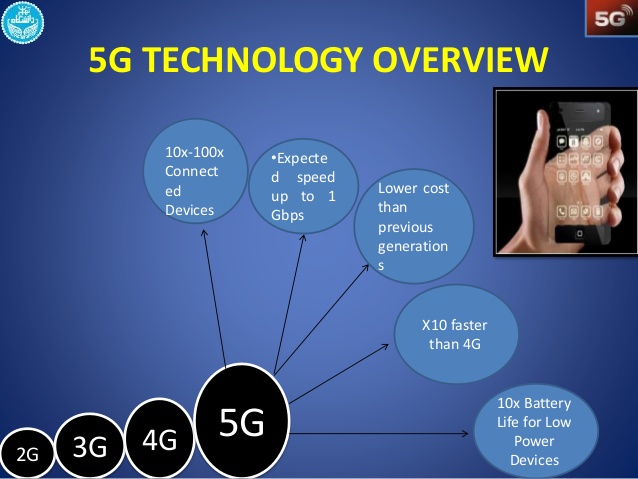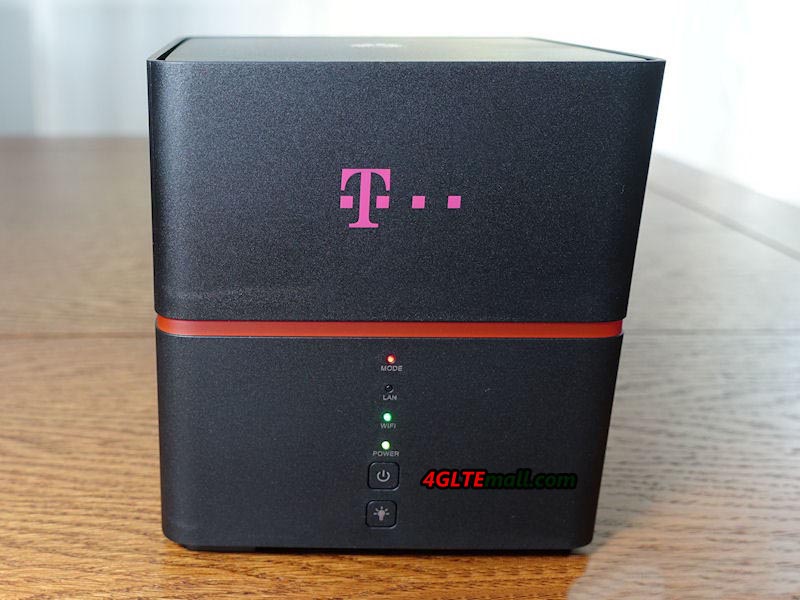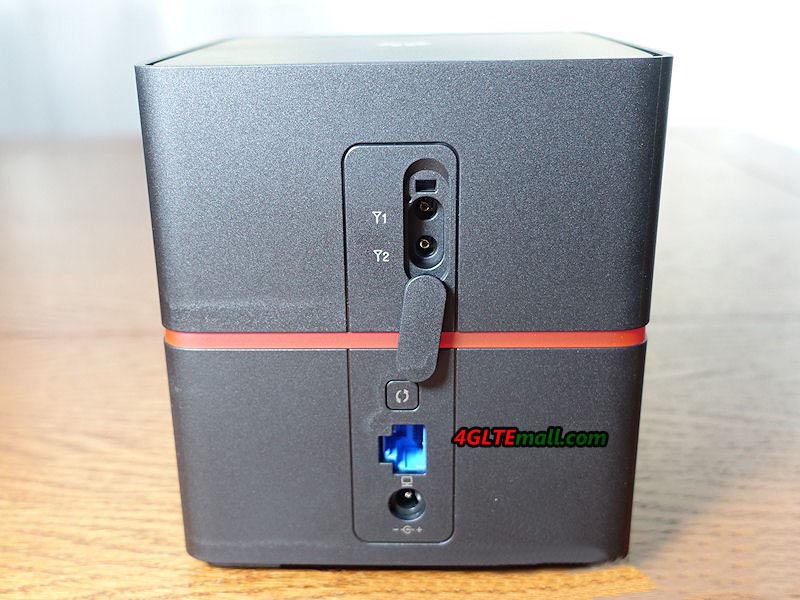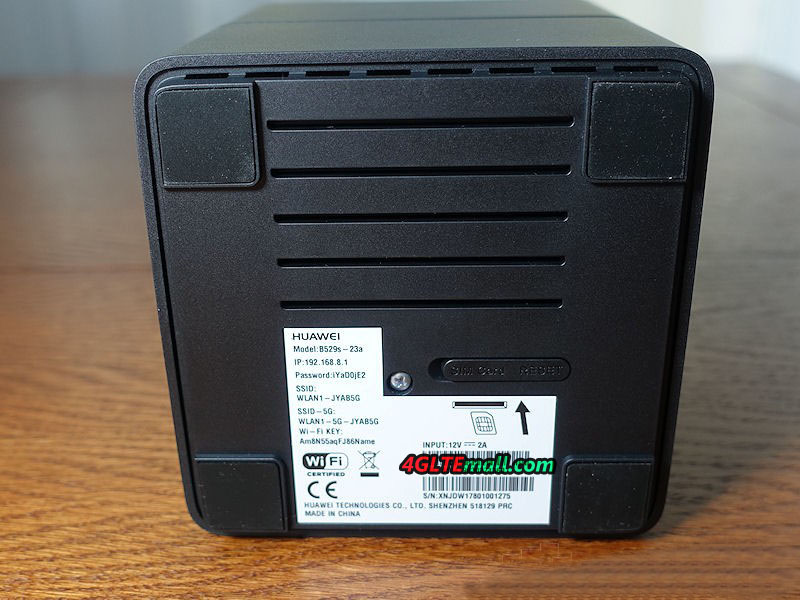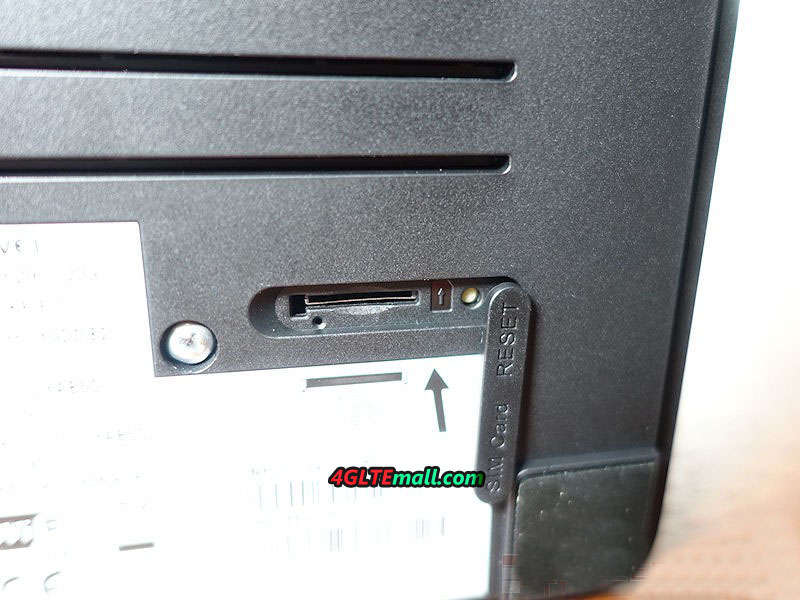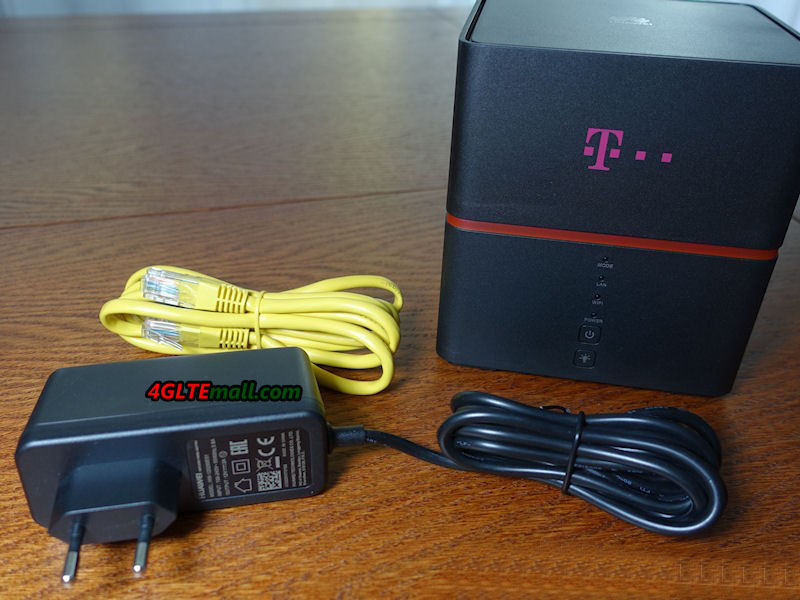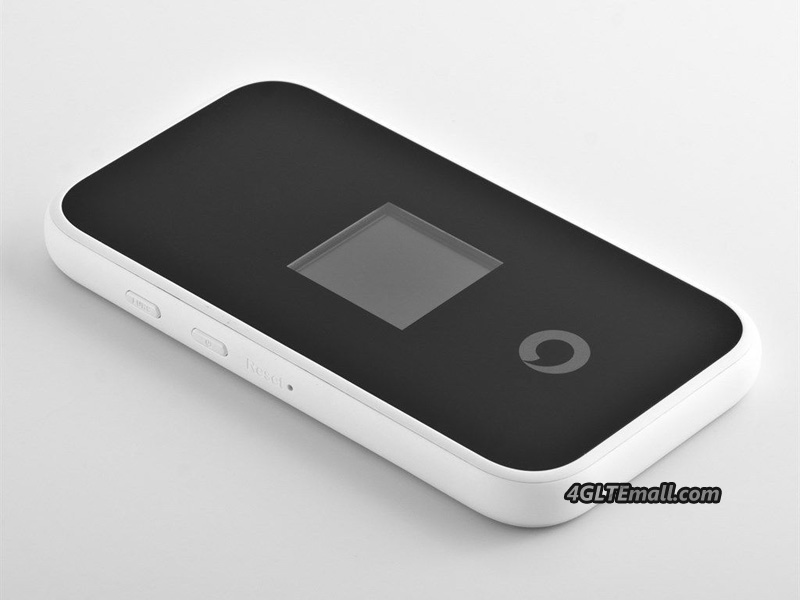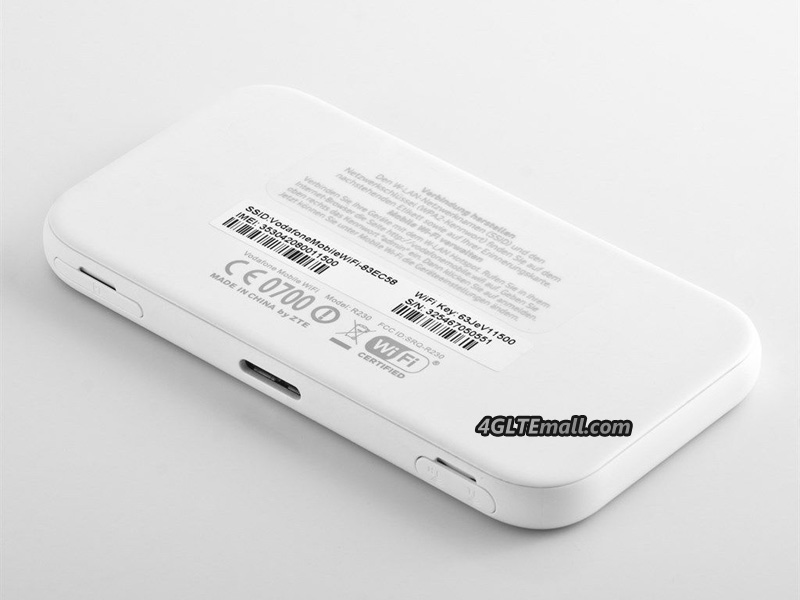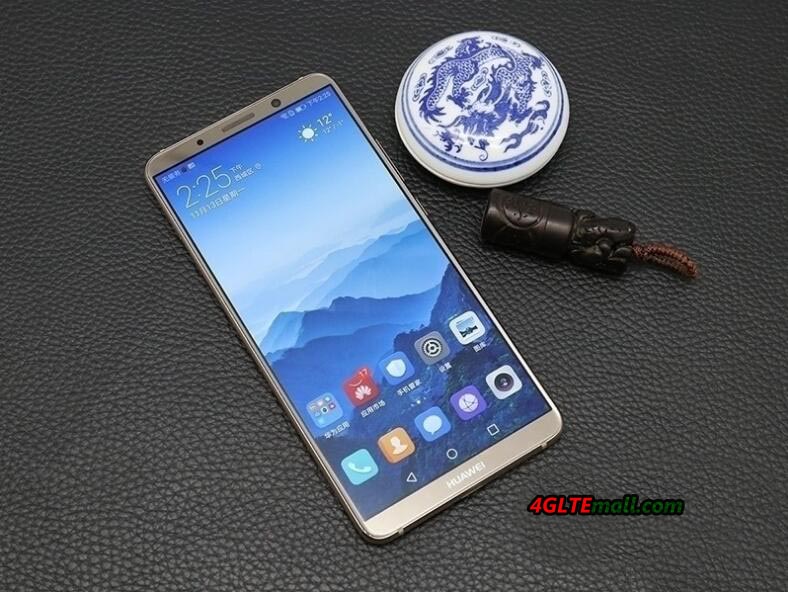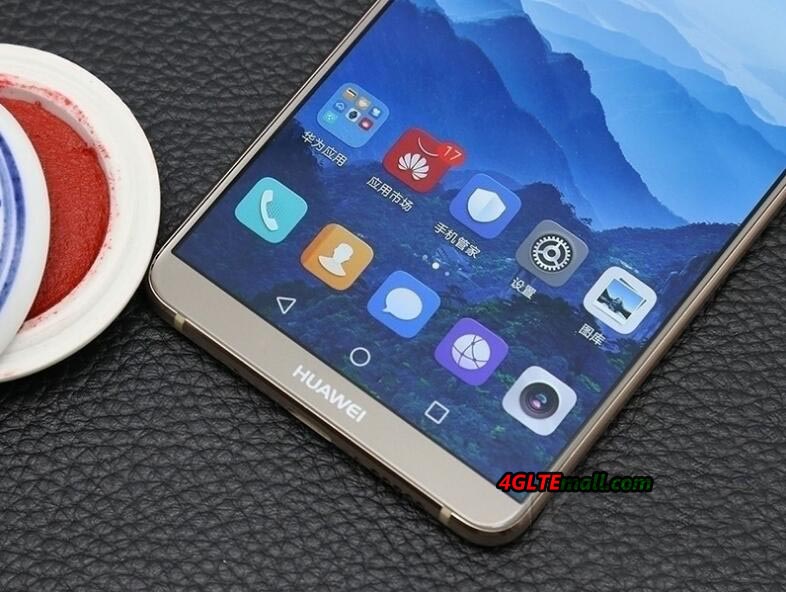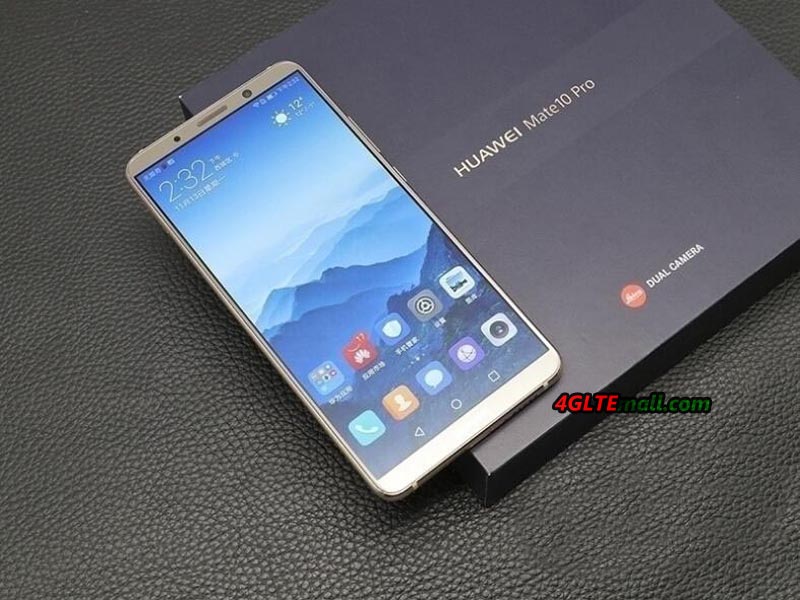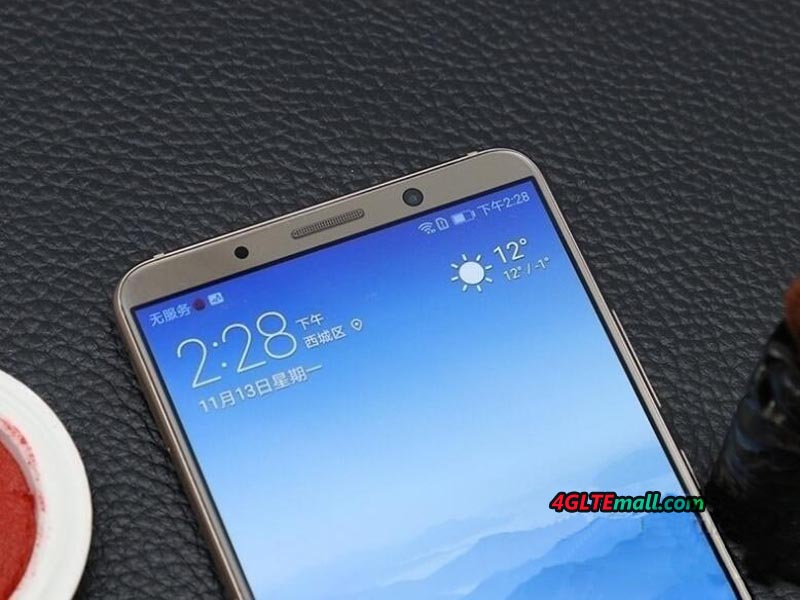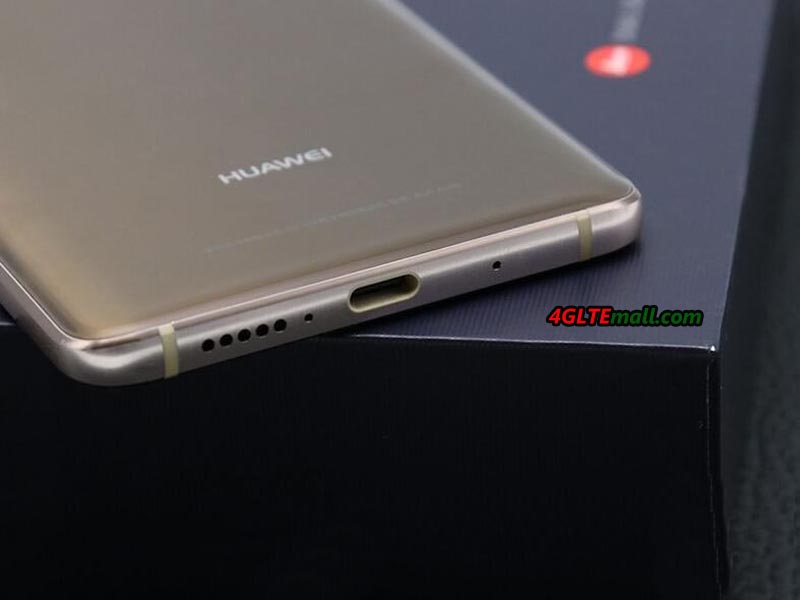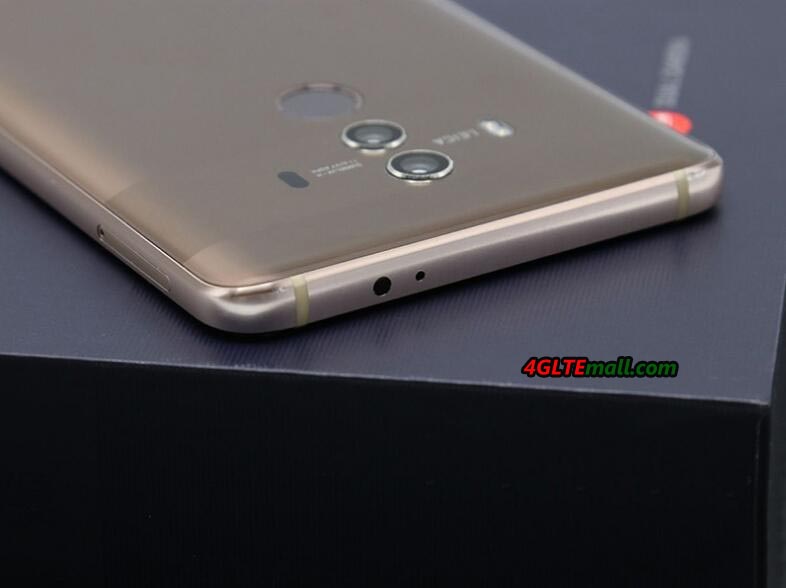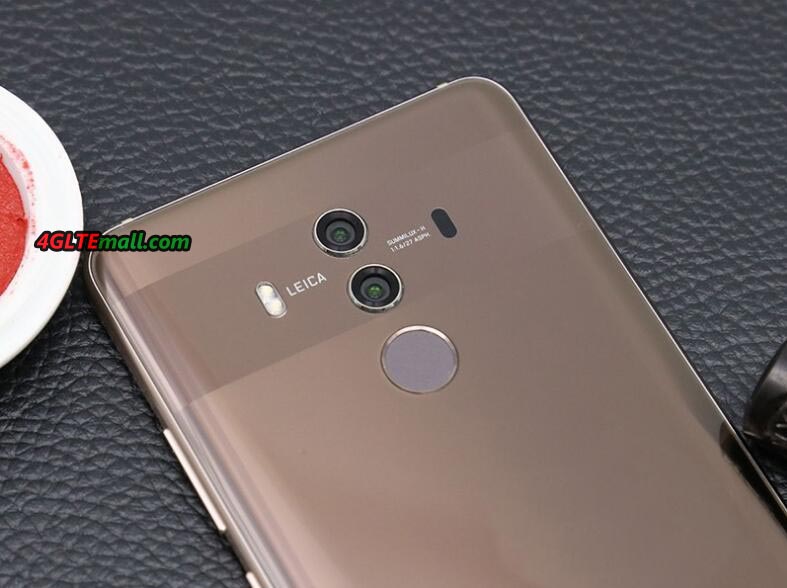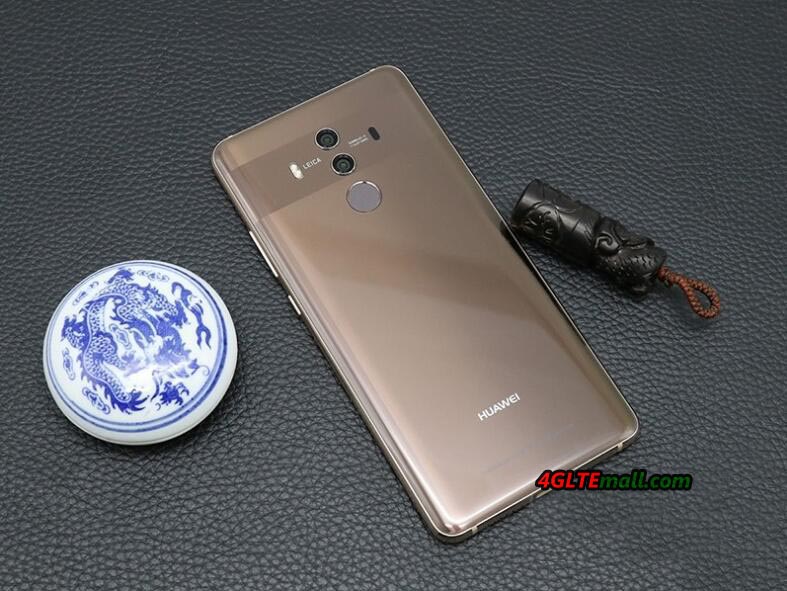2017年12月24日 星期日
Alcatel One Touch L850V LTE Cat.4 USB Stick
2017年12月21日 星期四
Huawei E5785 LTE Mobile Hotspot Test
Huawei has launched the new E5785 LTE hotspot on the market. With not-high price, it still offers good facilities. The Huawei E5785 has an LTE Cat6 modem for speeds up to 300 Mbps in the downlink and presents information about the device and the Internet connection via a small display on the front. There is dual-band Wi-Fi and the battery should allow about 10 hours of operation. Today, we would take a test on this new LTE hotspot.
Appearance
Huawei presented the E5785 as a successor to hotspots like the Huawei E5377 or the Huawei E5577. Visually, the E5785 differs little from the aforementioned predecessors, technically LTE Advanced Cat6 but now arrived in the middle class. With the battery, a quick-start manual and an extremely short micro-USB cable are packed with the E5785 device. To charge, you have to choose an existing USB power adapter or any USB port on your PC or laptop.
The first impression of Huawei E5785 is good. For the test, the white version of the E5785 was available, but there is also a variant with black color to buy. The device is small and light and has two buttons: a power button on the front and a menu button on the side. The battery is replaceable; under the battery is the slot for the MicroSIM card. Good to know: Even NanoSIM cards with adapters work well when used with care. On the front there is a small rectangular display, which is easy to read and clearly displays important information.
Technical specifications
The Huawei E5785 offers the following specifications. Importantly: the exact model number E5785Lh-22c would work without any trouble in Europe. If you buy a device with a different model number, other frequency ranges may be supported.
| Manufacturer & Model: | Huawei E5785Lh-22c |
| technologies: | LTE / 4G (Cat6) | UMTS / 3G | GSM / 2G |
| Frequency ranges: | LTE FDD: B1 / B3 / B5 / B7 / B8 / B20 / B32 LTE TDD: B38 UMTS: B1 / B2 / B5 / B8 GSM: B2 / B3 / B5 / B8 |
| CA combinations: | Intra-band: B3 / B7 / B38 Inter-band: B3 + B5 / B3 + B7 / B3 + B8 / B3 + B20 / B7 + B8 / B7 + B20 |
| Maximum speeds: | LTE: 300 Mbit/s down, 50Mbit/s up | UMTS: 42.2 Mbps down, 5.76 Mbps up (using DC-HSPA+) | GSM: 236 kbps (when using EDGE) |
| WIRELESS INTERNET ACCESS | 802.11a/b/g/n/ac to 867 Mbps | 2 × 2 MIMO | 2.4 GHz or 5 GHz | Up to 10 devices at the same time |
| Software in the test: | Firmware Version: |
| Others: | 2 x connection for external antenna (type TS-9) | Replaceable battery 3,000 mAh | MicroUSB connection |
Configuration and software
Confirguration is simple and easy. After power on the device, you have to connect via WLAN with the Huawei E5785, then you can enter the SIM pin and set up by Huawei HiLink App (available for Android and iOS) or via the browser web interface (IP: 192.168.8.1). An assistant leads through the most important settings, so that even less experienced users should be able to cope quickly. The used provider is recognized automatically via the SIM card, and normally the APN does not have to be entered.
Further settings can be made in the web interface, for example, roaming for the use of the device abroad can be activated or the mobile network technology can be selected manually. You can store a data plan in the statistics menu and it is possible to send and receive text messages.
Huawei E5785: modem in the test
The modem of the Huawei E5785 left an ambiguous impression in the test. If the reception was good, the LTE hotspot delivered excellent data rates - in an LTE 800 cell (Volume 20) almost 70 MBit/s in the downlink and around 25 MBit/s in the uplink were possible. However, the reception was not always satisfactory overall and with poor reception, the modem also provided comparatively bad values: a Netgear Nighthawk M1 provides almost double times fast while a Huawei B618 LTE router even three times as fast. The mobile hotspot showed no weaknesses over UMTS, in this case the speeds were often even higher than the comparison devices.
To achieve the maximum possible speed, Huawei E5785 bundles different channels in the same or in different frequency ranges (see table above, "CA combinations"). In the test, the maximum data rate was about 200 MBit/s - significantly more will probably reach only very rarely, because the LTE networks of the providers are now often well utilized.
If required, an external LTE MIMO antenna can be connected to the Huawei E5785. For this purpose, two TS-9 connectors are available under a cover at the side. In the test, the use of a 40dBi LTE MIMO antenna with two TS-9 pigtails worked flawlessly.
WLAN with extender function
The WLAN of the Huawei E5785 operates either in the frequency range around 2.4 GHz or in the range around 5 GHz. The 802.11a/b/g/n/ac standards are supported with 2 × 2 MIMO antenna technology. Over 2.4 GHz are possible up to 300 MBit/s, on 5 GHz up to 867 MBit/s. In the test, the maximum connection speed was reached with an Apple MacBook Pro even at about 4m distance (line of sight), but as soon as objects or even a wall between hotspot and terminal are, the speed drops significantly. Overall, the range was neat, not better or worse than other mobile Wi-Fi hotspots. What was conspicuous: when using 5 GHz WLAN, the Huawei E5785 always needed about a minute after power-up to perform the DFS scan.
During this time the WLAN connection was not usable. Huawei has again integrated the WLAN Extender function on the E5785, as with many previous models. The function allows using an existing WLAN connection as Internet access, as soon as it is within reach. This saves data volume at the data tariff. The WLAN Extender must be configured once via the web interface or the Huawei HiLink App, but can then be switched on and off on the device itself via the menu and the power button. In the test it was noticeable that the speed was limited to about 15 MBit/s when using the WLAN Extender function. However, this is not only the case with the E5785, the sister model Huawei E5885 also had this restriction.
Battery and others
The battery of the Huawei E5785 is to allow about 10 hours of operation according to the manufacturer. In the test this was approximately achieved, with the operating time varies slightly depending on the application scenario. If you use the LTE hotspot in a train or in a car, where cell changes often have to be carried out, the battery life is slightly lower than for stationary use. The number of connected WLAN devices also has an impact on the runtime.
The Huawei E5785 does not have a MicroSD memory card slot. The site has a micro-USB port for charging and connecting to the computer. Even if no device is connected via WLAN and the Internet connection is exclusively used via USB: you can not completely switch off the WLAN.
Conclusion
Overall, the Huawei E5785 left a good impression in the test. The battery life is good, the setup was fast and the operation is very easy. Wi-Fi and modem worked perfectly in the test, the LTE speeds with weak reception but could be improved.
The Huawei E5785 has to fend off competition, especially from its own home: the LTE hotspots Huawei E5577C and Huawei E5377 are a bit slower and have a shorter battery life. A slightly more expensive alternative is the Huawei E5787 with a large touch screen and the Huawei E5885 with LAN connection on. Recently, Huawei released a new Gigabit LTE hotspot Huawei E5788, we suppose the price of Huawei E5785 would drop soon after the new model available on the market.
2017年12月19日 星期二
Huawei MS2372 -- LTE Stick for the Industry
USB surf sticks with LTE modem were the first devices for the first LTE networks in 2011, with which you could use the new mobile network of the fourth generation. In Europe, for example, the Samsung GT-B3740, Huawei E392u-12 and the Huawei E398 were widely used. In the meantime, at the end of 2017, LTE surf sticks in the end customer sector hardly play a role anymore. Most customers want to use a LTE hotspot with WLAN and battery for mobile use and a "real" LTE router with LAN and WLAN function for stationary use as a DSL replacement. For industrial applications, Huawei now presents a new LTE stick: Huawei MS2372.
Huawei MS2372 Applications According to the manufacturer, the Huawei MS2372 LTE USB stick can be used, for example, in mobile sales terminals, in vending machines, in consumption meters or in medical device. These devices require a connection to the Internet for a variety of reasons and can be upgraded with the LTE Stick as needed. For example, a remote update of certain devices is possible or a vending machine can report transactions in real time to the central office. The Huawei MS2372 seems to replace the previous old model Huawei E220 modem, which was widely used in various terminals. To support different LTE frequency bands from various network carriers, Huawei also presents many sub-models like the Huawei E3276 LTE Stick to support these networks:
Huawei MS2372h-517:
* LTE FDD B1/B2/B4/B5/B7/B12/B28
* UMTS B1/B2/B4/B5
* GSM:850/900/1800/1900
Huawei MS2372h-153:
* LTE FDD B1/B3/B7/B8/B20
* UMTS B1/B8
* GSM 850/900/1800/1900
Huawei MS2372h-607:
* LTE FDD B1/B3/B7/B8/B19/B28 and LTE TDD B40
* UMTS B1/B6/B8/B19
* GSM 850/900/1800/1900
Extended temperature range For the consumer market, usual LTE modems work only in a quite limited temperature range. For the MS2372, Huawei has significantly extended this temperature range, the stick works between -20 and +55 degrees Celsius. The USB modem requires a power supply of 5V / 700mA for operation and is quite compact at 88mm x 28mm x 11.5mm. The weight is just under 50 grams.
LTE Cat4 with 150 MBit/s The maximum speed in the LTE network is around 150 MBit/s in the downlink and 50 MBit/s in the uplink. This corresponds to LTE category 4. In addition, the stick is backwards compatible with 3G/UMTS and 2G/GSM, including the data accelerators DC-HSPA+ and EDGE. The following frequency bands are supported by the model MS2372h-153 designed for the European market:
- LTE: B1/B3/B7/ B8/B20
- UMTS: B1 / B8
- GSM: Quadband (50/900/1800/1900 MHz)
On the side of the USB stick, there are two connections for external antennas under one cover.
Control via AT commands
The Huawei MS2372 LTE stick can be controlled via AT commands, in addition to the 3GPP TS 27.007 and 27.005 standards, extended Huawei AT commands are also supported. Availability The Huawei MS2372 would be available soon around the beginning of 2018. We would take test for this new LTE stick and show our report on www.4gltemall.com.
2017年12月17日 星期日
Huawei B612 LTE Router Features and Specs
Huawei offers a new wireless LTE CPE B612 with powerful LTE modem recently. The B612 CPE supports LTE Advanced Cat6 with up to 300 MBit/s in the downlink and up to 50 MBit/s in the uplink, which is similar to the predecessor Huawei E5186 and B525 technically. A special feature compared to the predecessor model is the support for 4 × 4 MIMO antenna technology. The router also offers a telephone function and connections for external LTE antennas, which are common specs for the Huawei LTE routers. Here now in some countries, the Huawei B612 LTE CPE is already available.
Huawei B612: design and comparison
The Huawei B612 looks like a classic router, there is no special design or visual highlights. The case is held in matt white plastic. On the front several LEDs show the operating status, on the back you will find the connections.
But where can you roughly classify the Huawei B612 compared to other Huawei LTE router models? One thing is clear: the Huawei B618 with 600 MBit/s and 4 × 4 MIMO antenna technology has a much more powerful modem, but puts the focus much more on the body design and has fewer connections. The Huawei B715 LTE router can also use much higher speeds than the B612 at 450 MBit/s, but does not use 4 × 4 MIMO antenna technology. The B715 also has the most connections in the comparison with B612 and B618.
Huawei B612: Specifications
As we know, Huawei had presented two sub-models for Huawei B612. We suppose there will be more models available in near future, just like the Huawei B593 LTE CPE. The Huawei B612 offers a LTE Cat6 modem for up to 300 MBit/s in the downlink. In addition to 4 × 4 MIMO antenna technology, 2CC CA (dual channel bundling) is also supported. In addition to FDD LTE, TDD LTE is supported, so the router is very universal. The following LTE frequency bands are supported in detail as below:
Huawei B612s-25d support:
* LTE: B1/B3/B7/B8/B20/B38/B40/B41(2545~2655MHz)/B42/B43
* DC-HSPA+/HSPA+/HSPA/WCDMA: B1/B8
* EDGE/GPRS/GSM: B2/B3/B5/B8
* 4*4 MIMO:B3/B7/B20/B38/B40/B41/B42/B43
Huawei B612s-51d support:
* LTE: B2/B4/B5/B7/B41(2545~2655MHz)
* DC-HSPA+/HSPA+/HSPA/WCDMA: B1/B2/B5
* EDGE/GPRS/GSM: B2/B3/B5/B8
The WLAN module of the Huawei B612 operates both in the frequency range around 2.4 GHz and 5 GHz and supports the 802.11ac standard. For connection to computer and game console, there are also four RJ45 Ethernet LAN ports on the back of the router. If you want, you can also use one of the four LAN ports as a WAN connection, ie an external modem can be connected there. The internal mobile modem is then disabled and you can use the router as a normal wireless access point.
On the back you will find other connections besides the RJ45 LAN ports. On the one hand, there is the RJ11 connection for an analogue telephone, because the B612 supports telephone connections. On the other hand there are two SMA connections for an external LTE MIMO antenna, the connections are well protected under a cover.
Huawei B612: availability
Here now the Huawei B612 is only available for few network provider in Poland and Chile, and the online retailers don’t have this new LTE CPE available. We suppose it would be available soon around the beginning of 2018, just like the predecessor huawei LTE router. We will take further test on this router once we get it. And we would also inform the availability if we have news from 4gltemall.com.
2017年12月13日 星期三
Telekom Speedbox LTE IV Router Test
Telekom has introduced a new LTE router- Speedbox LTE IV to its product range. The Speedbox LTE IV is the successor of the Speedbox LTE III, which was offered since January 2015 and left a good impression on the users. Compared to its predecessor, the Telekom Speedbox LTE IV offers twice as high speeds (LTE Cat11 with up to 600 MBit/s), as well as a sleek new design. Manufacturer of the device is the Chinese company Huawei, and the router is a slightly modified Huawei B618s-22d.
Connections and design
The Telekom Speedbox LTE IV is visually certainly one of the most beautiful LTE routers that are currently available. The matt white cuboids also looks good on a dresser, unlike many other routers, the device does not need to hide. Various LEDs on the front indicate the operating status as well as the reception, a WPS button ensures fast WLAN connections without tedious password entry. The MicroSIM card is used on the underside of the Telekom Speedbox LTE IV; there is also a label with serial number and Wi-Fi password attached. The power supply, LAN cable and external antenna connectors are located on the back panel. In detail, we can find here 2x RJ45 Gigabit Ethernet and two TS-9 connections under a cover. But unlike the original Huawei B618s-22d router, there is no USB or an RJ11 telephone connection in the Speedbox LTE IV. And it doesn’t have built-in battery, which feature is available on another similar router Huawei B529s-23a. The Speedbox LTE IV must get external power supply and work.
| Telekom Speedbox LTE (Huawei B618s-22d) hightlight features: | |
| LTE | Category 11, down to 600 Mbps, up to 50 Mbps |
| LTE frequency bands | FDD LTE Band 1/3/7/8/20 (800/900/1800/2100/2600 MHz) |
| UMTS | DC-HSPA+, up to 42.2 Mbit/s downlink, up to 5.76 Mbit/s uplink |
| UMTS frequency bands | 900/2100 MHz |
| GSM | Including EDGE |
| GSM frequency bands | 850/900/1800/1900 MHz |
| connections | 2x Gigabit LAN, 2x TS-9 for external antenna |
| WIRELESS INTERNET ACCESS | WLAN 802.11a/b/g/n/ac, up to 867 Mbps |
| Others | LAN port can also be used as WAN port. Operation via browser and via app possible. |
LTE speed in practice
Even though the LTE modem of the Telekom Speedbox LTE IV theoretically reach up to 600 MBit/s fast: in practice, only a fraction is reached in the normal case. For the highest possible speeds, not only the LTE advanced pro mobile network must be equipped accordingly, the network utilization may only be very low, which is rarely the case in modern times. Of course, the reception must of course be as optimal as possible. Much more interesting than the question of how maximum fast the router will be is the question of how the speeds are in areas with poor reception and how the device beats in comparison with the competition.
The transmission and reception performance is quite decent with the Telekom Speedbox LTE IV, but does not trigger any enthusiasm storms. If in doubt, you should connect with very poor reception an external antenna. The speeds were above average in the LTE network and in the UMTS network in comparison with a Netgear AirCard 810 hotspot , an Apple iPad Pro 9.7 and an AVM FRITZ! Box 6890 LTE. Tested in the LTE 800 and LTE 1800 network of Telekom and Vodafone, UMTS was used at 2100 MHz.
The continuous use was easily possible in the test, the SpeedBox LTE IV ran smoothly for several days and was doing little more than lukewarm. What was noticed during the test, however: with heavier load (eg speed test) the power supply made noises, a kind of "coil whistling" was to be heard.
WLAN at the Speedbox LTE IV
The WLAN of Telekom Speedbox LTE IV is strong enough to supply a large apartment or a small house. The range of course depends on various factors such as thickness and texture walls, but in comparison with common mobile WLAN/LTE hotspots, the range is good. The maximum speed is 867 MBit/s. The WLAN works on 2.4 GHz and 5 GHz (802.11b/g/n/ac), you can also switch off the frequency bands individually. The channel bandwidth can be set in the web interface, the highest speeds are obtained only with 80 MHz in the 5 GHz band. You can use the Wi-Fi bridge or Wi-Fi extender mode that allows you to use an existing Wi-Fi network as an Internet access. If a device is connected to the Telekom Speedbox LTE IV via LAN cable, a menu is displayed in the web interface with which the WLAN can be completely switched off.
Hidden WAN function
As already described, the Telekom Speedbox LTE IV offers two RJ45 Gigabit Ethernet interfaces on the back. These connections can be used, for example, to connect a desktop PC or game console with a LAN cable to the LTE router. If you need more than two LAN ports, you have to switch between a switch. In the test, the LAN connections worked smoothly, as expected.
The Speedbox LTE IV has a nice feature that the "original" Huawei B618 taken: if necessary, one of the LAN ports can also be used as a WAN port, ie you can feed an existing Internet connection via LAN cable and thereby possibly save mobile data volume. It should be noted, however, that you no longer have access to the Web interface when using the WAN. Settings on the WLAN must therefore be carried out beforehand, before the WAN function is used.
Configuration via web interface
The web interface of the Telekom Speedbox LTE can be reached in the browser via the address 192.168.8.1. On initial startup, you are prompted to change the log in password to a custom one, eliminating unauthorized access and configuration changes. On the start page you get the most important information displayed clearly, including, for example, the amount of data consumed and the online time. Of course, the reception is also displayed, but you can also find it in any other menu at the top of a status bar. There are also tabs for "Statistics", "SMS", "Update" and "Settings". Basically, the points are self-explanatory and quite clear, only in the settings, there are many sub-points, which are worth a close look.
In the tab "Settings" you can specify, for example, whether the router should also go abroad (roaming) to the Internet and whether the network technology (2G, 3G, 4G) should be selected automatically or if you prefer to use only LTE, for example , The configuration of the WLAN interface can also be made here: up to 4 WLAN names (SSIDs), two each at 2.4 and 5 GHz, can be assigned, of course, each with an individual password. Some simple settings can also be made via the Huawei HiLink Smartphone App, which is available for Android and iOS in the respective App Store for download. If you just want to see the current data consumption quickly or want to read a text message, you will be fine with the app. For more detailed things, such as the choice of network technology, you still have to try the web interface, here comes the app to its limits.
Test conclusion to the Telekom Speedbox LTE IV
In the test, the Speedbox LTE IV made a good impression: the Internet connection was stable and reliable, the modem reached high speeds and the case design is a clear advanced to its predecessor. The software is fast and easy to use and the WLAN module was convincing with up to four SSIDs and high speeds.
However, there are also some criticisms: on the one hand Telekom has deleted the telephone interface, which is the otherwise identical to original model Huawei B618s-22d available on 4gltemall.com. On the other hand, a WiFi Extender function is missing, with which one can use an existing WLAN as Internet entrance, as it is often already standard with many mobile LTE hotspots nowadays. The third point of criticism concerns the integrated LTE modem: it supports the advanced 4 × 4 MIMO antenna technology, but "only" 2CC CA, ie dual channel bundling.
Overall, it should be noted: apart from a few technical details, the Telekom Speedbox LTE IV is a highly recommended and future-proof LTE router. For the price with contract, there is currently no information. Considering the functions deleted by Telekom, we suggest you buy original and unlocked Huawei B618s-22d to enjoy the full functions for the LTE advanced router. The Huawei B618s-22d unlocked router is now available www.4gltemall.com. You can get it without any contract and use it with almost all the network providers’ SIM cards in Europe.
2017年12月12日 星期二
Huawei E5788 LTE Cat.16 MiFi Released
The fastest mobile LTE hotspot in Europe has long been the Netgear AC810, now Huawei has taken the lead with the new pocket WiFi E5788. The Huawei E5788 offers LTE Category 16, so speeds up to 1 gigabit per second download and up to 100 Mbps upload. In addition, the mobile Wi-Fi hotspot offers a touch screen and up to 10 hours of operation via the integrated battery.
Huawei E5788 with Gigabit LTE
The Huawei E5788 has an integrated LTE Advanced Pro Cat16 modem. To achieve speeds of up to 1 Gbit/s, the hotspot supports 4 × 4 MIMO antenna technology, 256QAM modulation and 3CC CA (triple channel bundling). The maximum possible speed depends not only on the E5788, but also on the mobile network. If the network is not equipped accordingly, the Huawei Hotspot offers lower LTE speeds. Of course, the E5788 Gigabit Hotspot is also backwards compatible with 3G/UMTS (up to 42.2 Mbps in the downlink) and GSM/2G can do the modem as well.
Huawei E5788: WiFi extender on board
The Internet connection is transmitted either over WLAN 802.11b/g/n/ac or over USB type C to connected terminals. Over WLAN, up to 32 devices can be supplied at the same time, the Huawei E5788 spits on 2.4 GHz and optionally also on 5 GHz. An RJ45 Ethernet LAN port, as offered by the sister model Huawei E5885, is not available on the Huawei E5788.
If required, the Internet access can be made via an existing wireless network instead of the integrated mobile modem. The feature called "WiFi Extender" is now standard on mobile Huawei LTE hotspots, including the E5788. In addition to the USB Type C port, which can be used to charge the battery and to connect to a computer, the Huawei E5788 also offers two TS-9 ports for an external LTE antenna. The connections are hidden on the side under a cover, which should protect against contamination.
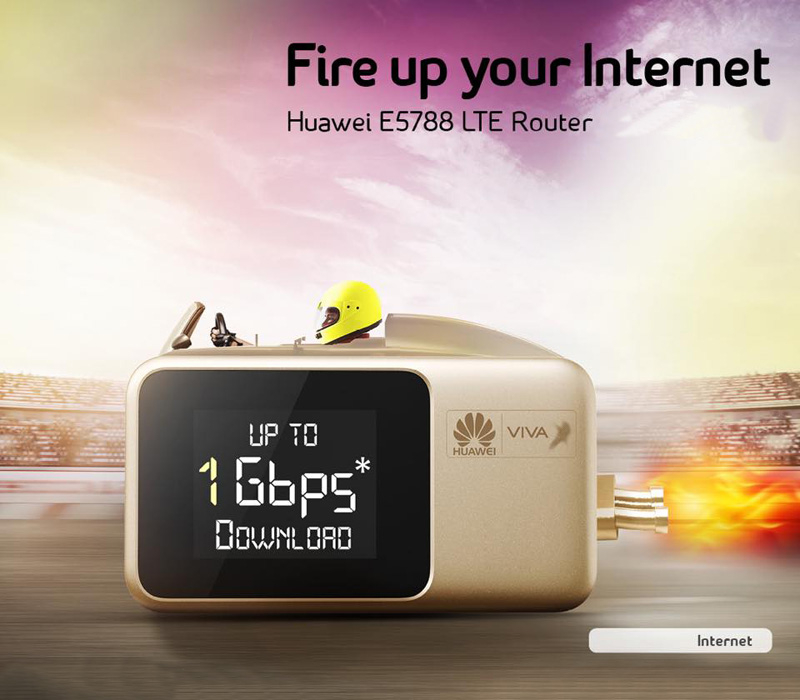
Huawei E5788: Operation via touchscreen
The Huawei E5788 has a small touch screen on the front, which makes it easy to adjust. The display shows important information about the Internet connection such as data consumption, online time and reception in the standard screen. In the first test, the touchscreen responded quickly and the operation was self-explanatory thanks to large icons. Further settings are possible via the browser web interface or the Huawei HiLink app. The battery of the Huawei E5788 is 3,000 mAh strong and unfortunately firmly integrated in the device, so not changeable by the user. The operating time is up to 10 hours, the standby time is up to 500 hours.
Huawei E5788: Availability
The Huawei E5788 is currently not available everywhere, but can be found via Google some online retailers, which have listed the suitable for European networks version Huawei E5788u-96a. Whether and when Huawei plans an official market launch in Europe is currently unknown. Should something new arise, this article will of course be updated. As alternatives, for example, the Huawei E5787 (with touch screen) and the Huawei E5885 (with LAN connection) are available; however, both devices reach a maximum of 300 MBit/s with the integrated LTE Cat6 modem. If you want Gigabit LTE mobile hotspot, you have to wait for the Huawei E5788.
2017年12月7日 星期四
Huawei B618s-22d 4G WiFi Router Review
The Huawei B618s-22d is a fast-moving mobile 4G router that creates a stable internet connection in every location. The device supports dual-band WiFi and connects to 64 devices at a time. This Huawei 4G router is also equipped with 2 Gigabit LAN ports.
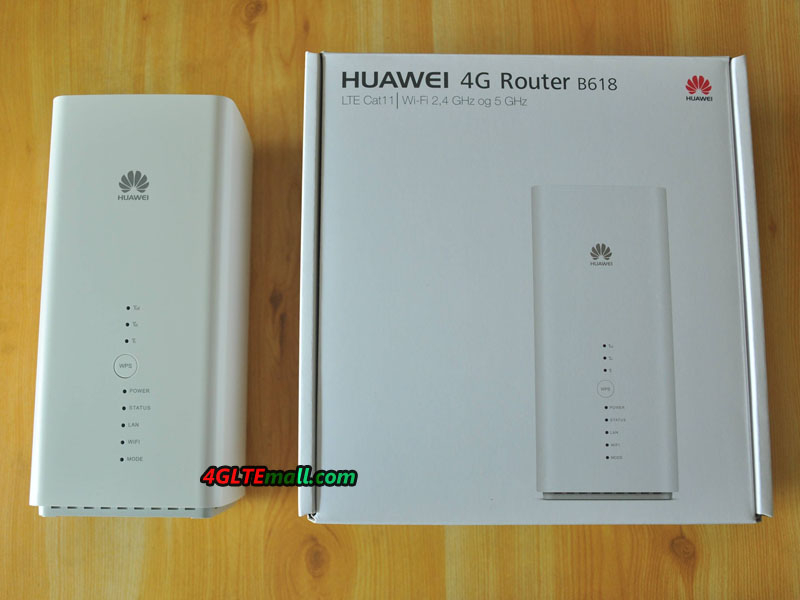
Huawei B618s-22d Features
* 4G LTE speeds up to 600 Mbps
* WiFi for 64 devices at a time
* Wireless-AC WiFi speeds up to 1300 Mbps
* 2 LAN ports (including 1 WAN / LAN)
* 1 RJ11 port for phone, printer or fax
* 1 Micro SIM card slot (Dual-Free)
* 2 External Aerial Ports (TS-9)
* 1 USB 2.0 Port
* Huawei HiLink App
* Weight: 700 grams
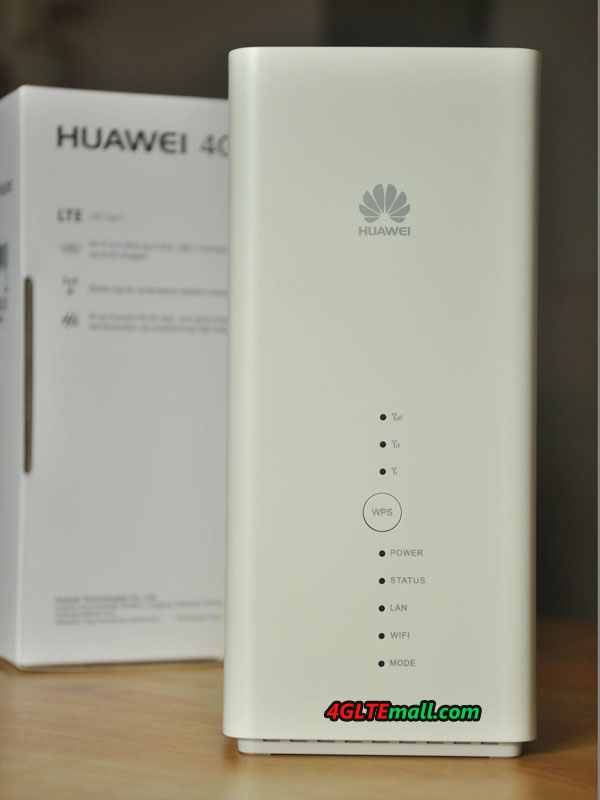
Fast 4G Router
The Huawei B618s-22d creates a fast 4G internet connection at any location. The device operates with a 4G LTE SIM card from any carrier and provides a wireless network at a speed of up to 582 Mbps. Up to 64 devices can connect to this router at the same time. If the signal is not strong enough, you may want to connect an external antenna. The huawei B618 CPE could also be used as a fixed WiFi router.
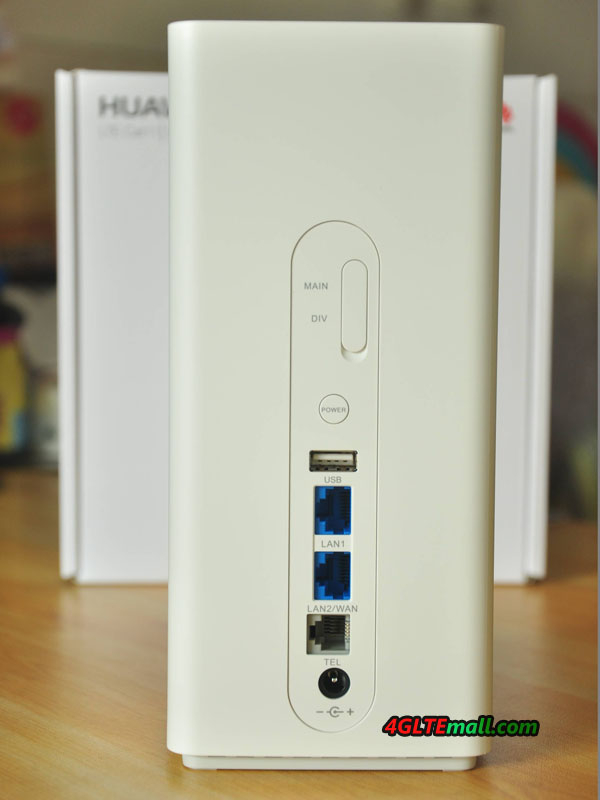
The Huawei B618s-22d has two Gigabit LAN ports, one of which also acts as a Gigabit WAN port. For example, you can use the router as a regular Wi-Fi router with wired internet. The Huawei B618s-22d supports dual-band wireless-AC (2.4 and 5GHz) with WiFi speeds up to 1300Mbps. The LAN ports can also be used to connect wired devices to the network, such as a fixed computer.
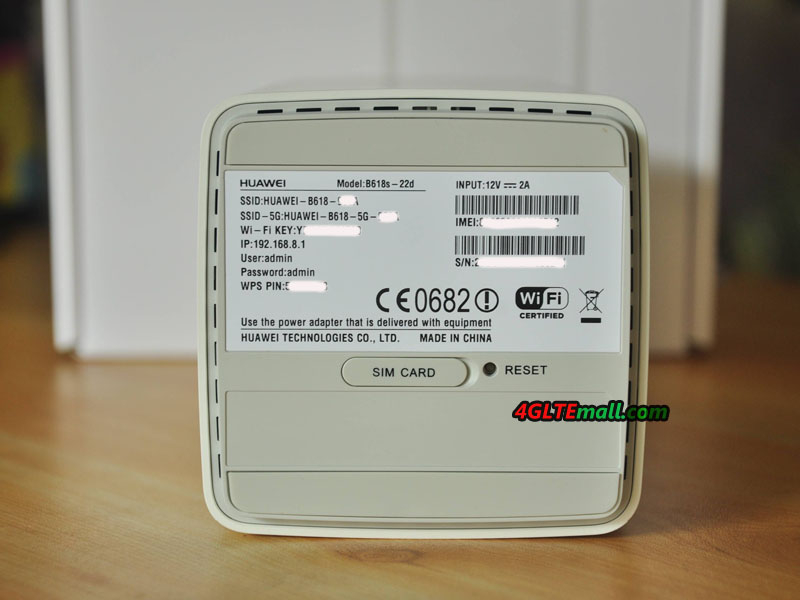
Telephone connection
The Huawei Huawei B618s-22d has a telephone port that allows users to connect a fixed analog phone, printer or fax. When connected to 3G, 4G or WiFi, you can call VoIP without any problems. This can be done with your analog or VoIP device, depending on your carrier. If you are connected to 2G, VoIP is not possible.
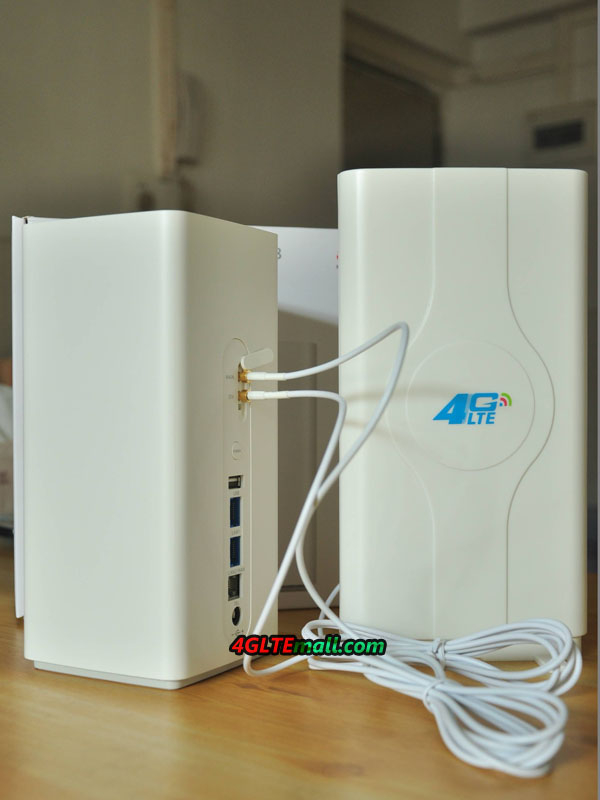
Huawei HiLink app
With the free Huawei HiLink app (available for iOS and Android), it's very easy to connect to the Huawei B618s-22d; Scan the QR code and you're done. Also, the router is easy to manage through the app. For example, remotely enable or disable Wi-Fi, check battery level and signal strength, read messages and find all connected equipment
Package Contents
- Huawei B618s-22d
- Power adapter
- Network cable
- Instruction manual
With the Huawei B618s-22d 4G+ router, you provide perfect network coverage for home in the outlying area or temporary locations such as a high-speed building kit. Thanks to 4G+, the maximum download speed via the mobile network is 600 Mbps. More than enough to download large building drawings or, for example, stream 4K movies. You connect to 64 wireless devices at the same time wkth this router. Would you rather use a fixed connection if it is available? Then connect the router to a network cable using your carrier's modem and use the device as a regular router. Via the USB port, you connect an external hard disk to share documents and media files with your entire network. In all, the Huawei B618 4G Router is a wonderful router with powerful functions. And it’s recommend if you need a home router for fast speed surfing!
2017年12月6日 星期三
3.5GHz May Be the 5G Frequency Band
The development of the next mobile communication standard 5G is progressing. Now it becomes clear that the frequency range of around 3.5 gigahertz will be the basis for 5G mobile networks worldwide. Confirmed Eros Spadotto from Canadian provider TELUS at the Huawei Global Mobile Broadband Forum in London. Even the network outfitter Huawei pleads for this frequency range in a position paper, summarizes it at 3.3 to 4.2 GHz but something further. Frequency spectrum in the range between 3.4 GHz and 3.8 GHz will be awarded in 2018 in many European countries, including a corresponding frequency auction is planned in Germany. In Canada, according to TELUS, an auction is expected in 2019.
5G Network Frequency: 3.5 GHz to start
The frequency range around 3.5 GHz will be available worldwide in many countries for mobile phone use. However, the area is not exactly defined yet, in most countries preparations are currently underway for the allocation of frequencies to the mobile network operators and the exact "limits" of the auctioned radio spectrum are not yet known. Huawei speaks in its position paper from the C-band, more specifically between 3.3 to 4.2 and 4.4 to 5.0 GHz. In order to expand 5G networks in a timely manner, the core range between 3.3 and 3.8 gigahertz is important, according to Huawei, and should be made available to network providers as quickly as possible. Some carriers in Europe uses the frequency range of 3.7 GHz in its 5G test network in Berlin, where it reaches speeds of 2 GBit/s, and the range is around 400 meters. The network provider expects the launch of the first 5G networks in exactly this frequency range, more specifically between 3.5 GHz and 3.9 GHz .
5G: more frequency ranges later
Although the range around 3.5 GHz will probably be used in many countries worldwide as a "base band" for 5G: significantly more radio spectrum is needed to achieve the need for bandwidth on the one hand and very good network coverage on the other. Huawei proposes three different "layers" in its position paper: the 3.5 GHz band should be sufficient as a "coverage and capacity layer" for most applications. On the other hand, very high speeds will demand significantly more radio spectrum, which will then be made available in the "Super Data Laye " - probably in the cmWave range around 28 gigahertz. Bruno Jacobfeuerborn, head of technology at Germany Telekom, assumes that at the start of 5G in the year 2020, this "super data layer" is not available, but only later expanded.
The third very important part in the 5G frequency spectrum is the so-called "Coverage Layer". So the area with which a huge network coverage can be achieved. It does not depend on extremely high data rates, but on the fact that a basic supply of 5G can be made available almost everywhere. Huawei proposes in its position paper for the "Coverage Layer" the frequency range below 2 GHz, which is currently used by GSM, UMTS and LTE. It is conceivable, therefore, that the network operators integrated the existing LTE networks into their 5G networks, making LTE an integral part of 5G. According to Eros Spadotto, the Canadian provider TELUS assumes that the frequency range around 600 MHz will be used in North America for the "Coverage Layer" of 5G. In Europe, the area around 700 MHz is more likely to be used for this purpose.
2017年12月3日 星期日
Huawei B529s-23a HomeNet Box Test
In mid September, T-Mobile unveiled its new LTE home internet service. The internet service comes with a new upgraded offer. With the new offer, the network has introduced a new "fixed" router Huawei B529s-23a Cube(T-mobile named it HomeNet Box), and we are now focusing on this device.
The Huawei B529s-23a is a new LTE router that is exclusively available on T-Mobile networks. The router is easy to use and does not require any additional installation. The user will get it with a SIM card inserted without a PIN code and the whole thing will be ready to use when you return home. Let's start with Huawei B529s-23a router specification:
- Dimensions: 120 × 120 × 127 mm, weight: 672g
- Frequency bands EDGE/GPRS/GSM: 2/3/5/8 (1900/1800/850/900 MHz)
- 3G / HSPA / DC-HSPA+ frequency bands: 1/8 (2100/900 MHz)
- LTE frequency bands: 1/3/7/8/20/32/38 (FDD: 2100/1800/2600/900/800/1500 MHz, TDD: 2600 MHz)
- Speeds: DC-HSPA+: 42 / 5.76 Mbps, LTE cat.6: 300/50 Mbps
- WLAN: 802.11a/b/g/n/ac (Dual Band 2.4/5 GHz)
- External Antenna Connections: Two TS-9 ports
- LAN / WAN connection (RJ45)
- Slot for microSIM card
- Built-in lithium-ion battery: 3000 mAh
- Dedicated power supply: DC 12V / 2A
- Support: DHCP Server, DNS RELAY and NAT, along with security services
- The router supports up to 64 devices
The appearance of the Huawei B529s-23a router is pleasing to the eye. Cube-shaped body with rounded edges, made of black plastic with a matte surface. It looks like the predecessor router Huawei E5170 LTE Cube. The accent is horizontal, through the middle of the belt in magenta. As it turns out, it is a glowing item, but luckily the backlight can be turned off with a button. In addition to the button mentioned above, the front panel and the four status LEDs, mode, LAN, Wi-Fi, power, are also included on the front panel. On the rear panel is a power connector, LAN/WAN port, antenna connectors, and WPS button (for automatically configuring Wi-Fi connections). The bottom of the "box" is the SIM card connector and the reset button. In addition, there is a label with predefined Wi-Fi network names and passwords.
As I mentioned, after being removed from the cardboard, the HomeNet Box B529 should be ready for operation. All accustomed to chargers with microUSB connector may be surprised, because there is a power adapter with a different connector, giving the output of 12V and 2A. It was probably easier and cheaper, especially since it was rather stationary. But as if you were going to take him away from home, it's the first of the popular chargers you will not use.
When connected to the power and start up, the user can use the provided password to connect to the wireless network and use the Internet. There will be two networks: one in the 2.4 GHz band and the other in the 5 GHz band. The name scheme is: WLAN1-JYABAG WLAN1-5G-JYABAG And that "-5G-" means a 5 GHz band, which is currently less used and less disturbed. Therefore, it is worth choosing.
We join and enjoy the benefits of the Internet and for many users it is enough to get the best possible coverage of a fast LTE network. In addition, the router provides the possibility to connect two external antennas. If you use the Huawei B529 Router at the location with weak signal, you can use LTE external antenna to get better surfing experience.
The Huawei B529s-23a is a device that offers far more capabilities than simple LTE modems. The first function is that the RJ45 port can works in both LAN and WAN mode, which means users can connect an Ethernet cable to the router and get wireless network from network provider. There is one SIM card slot in the Huawei B529s-23 router, user can insert a valid SIM card with data plan into the router and get wireless internet from the mobile network carriers. The two connection option makes users choose the data plan which suit best.
What’s more, the built-in battery with a capacity of 3000 mAh can provides about 1 hour of working time. This is not too much, but it is a protection against momentary power shortages and is a continuation of our backup communications. And user can take it outdoor and keep it working on the go. User can connect to the Huawei B529 router via the Huawei HiLink application, which gives you access to basic information. After logging in, you can check your connection status, the number of transferred data in the set billing period, and the connected devices. What is important for many people is to read and send text messages. You can also change settings for operator selection and preferred network type, eg "4G only".
However, access to the settings will only be possible after you log in to the administration panel. To get there, connect to a web browser with 192.168.8.1. To log in, users nee to use the standard login and password: admin / admin (we recommend to change immediately). When logged in to the panel, you will see basic connection information and device status. The next three menu items, Statistics, SMS and Update are also in the application. On the Settings tab, the most important options are grouped into eight items in the side menu. I will discuss them briefly in turn.
Quick Setup
Allows you to change the wireless network ID and password and to enable automatic updating of the device.
Connection settings
In this menu, you can set new APN access point profiles (default is already defined), select cellular mode (auto, only 2G, 3G only, LTE only) or network search mode (automatic / manual). We will also be able to disable data transfer or enable roaming data. However, there is no separate option for domestic roaming.
Ethernet
This is a menu in which, apart from the connection status, the RJ45 network interface mode can be set. Here we will determine whether the port works as a LAN or WAN, with additional parameters. In addition, there is also a MAC clone option - the hardware address of the network adapter.
VPN
VPN is a private network based on public links. Properly configured ensures confidentiality and communication security. Options built into the router allow you to establish a connection using the L2TP protocol. This menu will be used by more advanced users.
WLAN
Unlike the previous position, this should be used by almost every user. Wireless networks can operate both in the 2.4 GHz and 5 GHz bands, and for each band you can select the channel and bandwidth (defaults to automatic mode). Interestingly, for each band you can run two SSIDs, which gives you four visible networks. However, we will not find any additional options for separating users connecting to the router. Additional options are available for MAC address filtering and WPS settings to help you connect new devices to your wireless network. How do networks work in practice? Very good. The received network signal is stronger than the one that is offered by me, eg Horizon router from UPC. It is also slightly better compared to my second Asus RT-N16 router, which the manufacturer has armed with 3 external antennas.
DHCP
DHCP is a protocol for assigning network settings (including IP address) to the device connected to the router.
Security
It’s extremely powerful option that allows you to make changes to the default firewall settings. You can also block and filter devices, filter domains, and run port forwarding. DDNS (Dynamic Domain Name) is also available, but profiles are available for only three defined service providers. Interestingly, this group also includes the option to enable or disable the PIN code on the SIM card.
System
In this position you can check the status of the device, perform network diagnostics, change system settings and password, or restore factory settings. At this point you will need to make changes when you connect the external antenna to the router.
Summary
The Huawei B529s-23a router proved to be very solid and well equipped gateway for home users. Good performance, connectivity, good hardware and a decent enough (for such hardware) software functionality is the most important of its advantages. And the stability and strength of the wireless network proves to be good. The built-in rechargeable battery make the device can also be used as a mobile WiFi router.
Huawei B715 LTE Cat.9 WiFi Router Released
As a direct successor to the popular LTE Router Huawei E5186, Huawei presents a new LTE router B715 in Poland for the network provider “Play”. As a new LTE advanced router, the Huawei B715 reaches LTE category 9 with up to 450 Mbit/s in the downlink, which is a great improvement than the predecessor Huawei E5186 router. The B715 router has four RJ45 Gigabit LAN interfaces and a USB port, as well as an integrated telephone function with RJ11 connection. And we also see it’s available in Latvia for network carrier LMT with branded version.
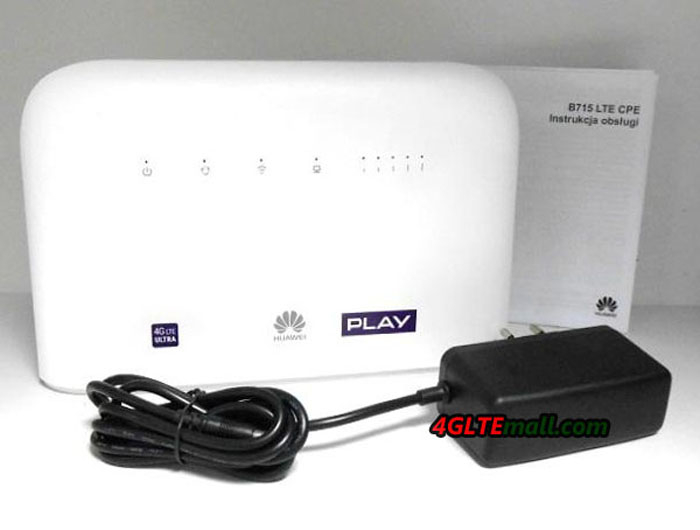
Huawei B715s-23c
The Huawei B715 is currently only available in Europe. The exact model name for the new Huawei LTE Cat9 router is B715s-23c. This designation recognizes the modem optimized for the European market; in other parts of the world, the B715 CPE may have a slightly different designation and thus different equipment with support of different frequency bands. Since the frequency ranges used in Europe are mostly same, as well as in Austria and Switzerland, the B715s-23c can also be used without problems in other Europe countries.
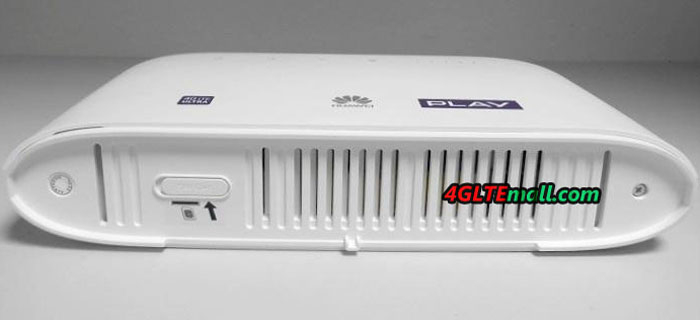
Huawei B715: 4.5G LTE Advanced Technology
The Huawei B715 has integrated LTE antennas, but also has two SMA connectors on the back for an external LTE antenna, which can be connected when needed. The LTE modem can connect up to three frequency ranges by means of carrier aggregation (channel bundling), which theoretically allows up to 450 Mbit/s in the downlink. In the uplink, up to 50 Mbps are possible via LTE. In addition to LTE, UMTS (3G) and GSM (2G) are also supported.
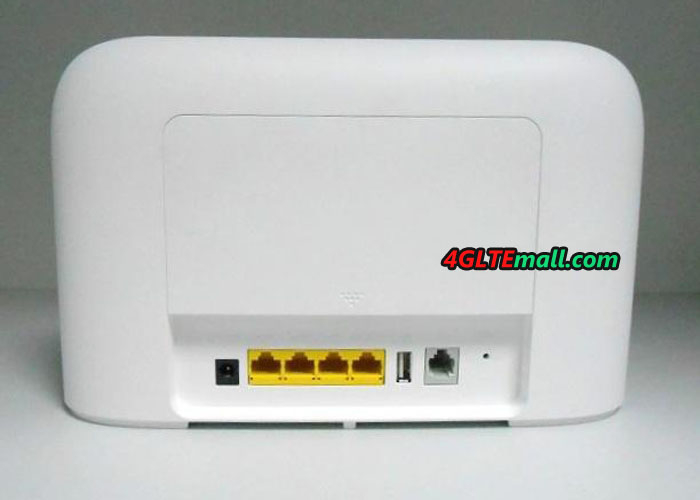
The RJ11 connector on the back panel of the Huawei B715 can be used to connect an analogue telephone, as well as a USB port for integrating a printer or storage media into the network. Wired devices can be connected via the four LAN ports. If required, one of the four LAN ports also acts as a WAN port, so the B715 can also be used with an external modem (eg fiber optic or cable modem). Wireless devices can connect to the Huawei B715s-23c via Wi-Fi, the router supports the frequency ranges around 2.4 GHz and 5 GHz.
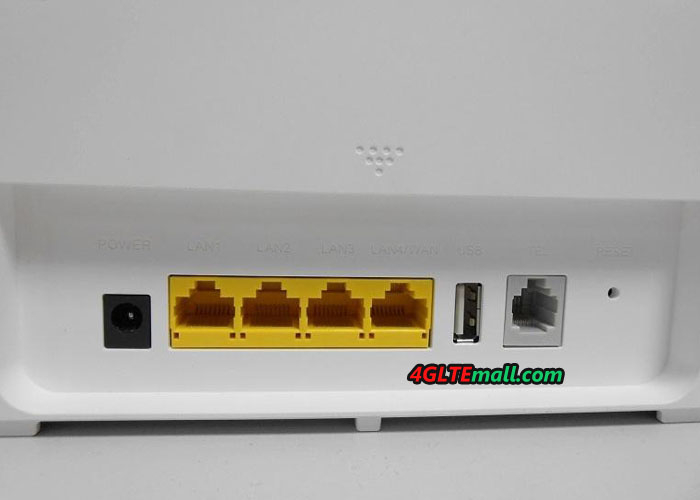
Huawei B715 and B618 in comparison
Attentive readers may already have noticed, with up to 450 Mbps, the new B715 LTE router is not the fastest router model in the Huawei product range. The Huawei B618 even offers up to 600 Mbps via LTE Cat11. The Huawei B618 also has the 4 × 4 MIMO antenna technology installed, the B715 can seem only on 2 × 2 MIMO antenna technology fall back. Nevertheless, the Huawei B715 also has advantages over the B618: there are four RJ45 Gigabit LAN ports and not like the B618 with only 2 TS-9 connectors, the B715 has the SMA ports for external antenna, which is common on Huawei LTE stationary routers. If you need the external antenna for Huawei B715 Router, we would like to recommend below the two antennas. We had tested the antennas and they can work well with Huawei B715 LTE Router: http://www.4gltemall.com/4g-antenna-two-sma-connector.html
If you prefer 4G outdoor antenna to get better signal, you could try below the antenna: http://www.4gltemall.com/4g-lte-outdoor-antenna-2-x-sma-connectors.html
We would take full detail test for the new Huawei B715s-23c router, and compare it with the more advanced Huawei B618. Keep follow on us(twitter: 4GLTEMALL) and we will update our test report once it’s done.
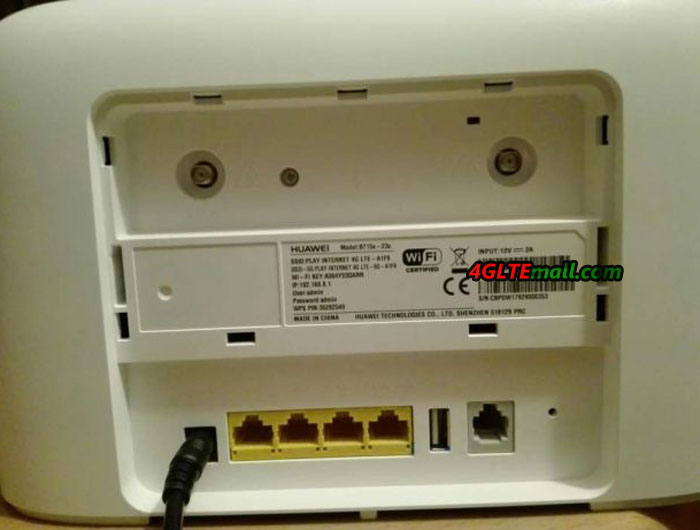
2017年11月30日 星期四
Vodafone R230 4G LTE Cat9 Hotspot Presented
With the development of the LTE network, Vodafone offers a new 4G/LTE mobile WLAN hotspot R230. The R230 pocket router supports speeds of up to 450 MBit/s in the downlink and up to 50 MBit/s in the uplink (LTE category 9) and is manufactured by the Chinese manufacturer ZTE. For a fast connection to wireless and wired devices, there are dual-band Wi-Fi and USB 3.0. With the unlocked Vodafone R230, users can use it with any SIM cards in Europe and take it for global travel.
Vodafone R230 -- Successor to R226
The Vodafone R230 is the successor to the Vodafone R226 LTE hotspot in the product range. Improved mainly the maximum downlink speed in the LTE network, further improvements are minimal or barely noticeable.
Vodafone R230: Fast LTE modem
The Qualcomm Snapdragon X12 LTE chipset in the Vodafone R230 hotspot can technically reach up to 450 MBit/s in the downlink and up to 50 MBit/s in the uplink, but Vodafone Germany only advertises the device with a maximum download speed of 375 MBit/s. The following LTE frequency ranges are supported: 800 MHz, 1400 MHz, 1800 MHz, 2100 MHz and 2600 MHz.
Of course, the Vodafone R230 router can also support UMTS/3G and GSM/2G networks, in the UMTS network, up to 42.2 MBit/s in the downlink and up to 5.76 MBit/s in the uplink are reachable. In the UMTS network, the bands are supported by 850, 900, 1900 and 2100 MHz, in the GSM network the bands can be used at 850, 900, 1800 and 1900MHz.
Vodafone R230: WLAN and other technology
On the front of Vodafone R230, you will find a small color display, on which the most important information about the Internet connection and device status are displayed. These include, for example: reception status, mobile phone technology, WLAN status and used data volume. On the side of the R230 MiFi, in addition to the USB port for charging the battery, there is also the slot for the SIM card as well as two connections for an external antenna. On the other hand, there is a power button and a function button. The battery has a capacity of about 2,200 mAh and is not changeable, according to Vodafone, the R230 provides an operating time of about 10 hours.
The WLAN works both on the 2.4 GHz frequency band and in the 5 GHz frequency range. The WLAN standards 802.11b/g/n/ac are supported, ie the fast LTE Internet connection should also arrive at full power at a connected terminal. As an alternative to WLAN, a USB 3.0 port can be used. The approximately 105 gram is very light, which makes it very easy to take in hand or pocket.
Vodafone R230 Availability The Vodafone R230 LTE hotspot comes pre-installed with Vodafone software and is offered by Vodafone in conjunction with the DataGo data plans. It's a customized hotspot from the ZTE MF980 4g mobile hotspot. We can provide the unlocked Vodafone R230 without the data plan. You can get unlocked R230 and use it with any network providers’ SIM cards in Europe. The unlocked Vodafone R230 would soon be available on www.4gltemall.com. We will keep updating the news. If you prefer the pure R230 without Vodafone customization, you can choose the factory model ZTE MF980 UFi, which has same specifications and functions.
Huawei Mate 10 Pro New Smartphone Test
Smartphones with large display and minimal edges are in vogue, Samsung has shown its Galaxy S8 with "Infinity Display" in the spring, Apple has recently launched its iPhone X and Huawei has the Mate 10 Pro now with large display and little rand on offer. But the Mate 10 Pro not only looks good, it also offers advanced technology with a chipset that will perform certain tasks much faster than previously known due to AI technology, which is the first time available in a smartphone. There are also dual SIM with LTE on both SIM cards in a single smartphone and an arrow-fast LTE Advanced Pro Cat18 modem for speeds of more than 1 Gbit/s in the LTE network. In the following test, we will check the features of the Huawei mate 10 Pro with advanced technology and chipset.
Huawei Mate 10 Pro: Design & Display
The Huawei Mate 10 Pro is made with an approximately 6-inch AMOLED display in 18: 9 format. The display has a resolution of 2160 x 1080 pixels, in the test, the presentation was very sharp and in terms of color and brightness, there was no reason to complain. OLED typical, the black value is extremely good, but the display is not particularly color stable at an oblique angle. The Huawei Mate 10 Pro has opted for a glass body. It is certainly a matter of taste, but personally I find a metal case still much more pleasant, even if the glass case without question has a higher quality and visually more powerful than the metal case of its predecessor Huawei Mate 9. Due to the nearly borderless display in 18: 9 format, the Huawei Mate 10 Pro is good in the hand, but a one-handed operation is still only with very large hands or with the help of the one-hand zoom mode. For the target group of the Huawei Mate 10 Pro, the one-hand operation is unlikely to be relevant anyway.
Huawei Mate 10 Pro: Kirin 970 chipset
At the heart of the Huawei Mate 10 Pro is the new HiSilicon Kirin 970 chipset. The octa-core processor is not only faster and uses less energy than its predecessor; it can also be used for the first time on AI support. The so-called "Neural Processing Unit", NPU for short, is intended to massively accelerate certain applications such as image recognition. Unfortunately this could not be tested in the test, because applications that use the NPU are still in short supply. With the camera app to use the NPU, the difference to other current smartphones is not quite noticeable. Probably the future has to show, whether the Mate 10 Pro will have a big lead by the NPU or not.
Incidentally, the internal memory of the Huawei Mate 10 is 128 gigabytes in size, whereby only slightly more than 108 GB can be used by pre-installed software. Personally, I think the size of the memory is sufficient, but many users would have liked something more with such an expensive high-end smartphone. Unfortunately, Huawei has no memory expansion option built-in, i.e a microSD card cannot be used. That is incomprehensible…
Huawei Mate 10 Pro: LTE modem
With the LTE modem of HiSilicon Kirin 970 chipset, Huawei has made great progress compared to the Mate 9. Not only is the maximum data rate of 1.2 Gigabit/s in the download extremely fast, but the device can be used in a much more countries than its predecessor by a significantly extended frequency band support. In detail, the following frequency ranges are supported:
- LTE (FDD): B1 / B2 / B3 / B4 / B5 / B6 / B7 / B8 / B9 / B12 / B17 / B18 / B19 / B20 / B26 / B28 / B32
- LTE (TDD): B34 / B38 / B39 / B40 / B41 (2545 ~ 2655MHz)
- UMTS (3G): B1 / B2 / B4 / B5 / B6 / B8 / B19
- GSM (2G): 850/900/1800/1900
The modem supports LTE Cat18 and can also bundle up to 5 frequency bands via carrier aggregation in addition to 4 × 4 MIMO antenna technology. In the downlink the 256QAM modulation is supported in the LTE network, up to 64QAM are possible in the uplink. Even if only 2 × 2 MIMO antenna technology is available and no frequency bands can be bundled, data rates of up to 200 MBit/s in the downlink and up to 75 MBit/s in the uplink can be achieved. Regarding the dual-SIM feature, the Huawei Mate 10 offers a world first: for the first time, a device supports LTE on both SIM cards slots simultaneously. For example, you can use the Mate 10 Pro as a mobile LTE/WLAN hotspot and at the same time make calls to the device via VoLTE.
In the test, the Huawei Mate 10 Pro's modem made a good impression: data connections were very fast and the reception was very good both in the UMTS network and in the LTE network. Also Wi-Fi speed and quality reception were good, especially the Wi-Fi amplifier or Wi-Fi bridge function liked. This allows you to use an existing Wi-Fi network as an Internet connection and pass it on to other devices via a Wi-Fi hotspot under a "new name".
Huawei Mate 10 Pro Camera
Not all details of the Huawei Mate 10 Pro are considered in this review, but the Leica dual camera on the Mate 10 Pro definitely deserves a separate section. The camera makes very good quality images and can of course make good shots at night, as you would expect from a current high-end smartphone. The image quality is ensured by a 20 megapixel black and white camera and a 12 megapixel color camera on the back, both with f1.6 aperture.
According to Huawei, the NPU (ie the AI unit of the processor) is also used for the camera; in automatic mode, subjects should be detected more quickly. In practice, however, this is hardly noticeable, as a result, other current top smartphones like the Apple iPhone 8 make at least equally good pictures, even without explicit motif recognition. But according to Huawei, the NPU "learns" over time.
Huawei Mate 10 Pro Test: Conclusion
This review does not cover all facts of the Mate 10 Pro, but after the extensive test, the following conclusion remains: With the Mate 10 Pro, Huawei has a very good smartphone in the range. It offers a chic design, a very good camera and very advanced wireless technology. The use of the heavily advertised NPU or the AI functions remains somewhat unclear after the test. Even the missing 3.5mm jack and the missing memory card slot are definitely negative points. Overall, the overall package in comparison with the Apple iPhone X and the Samsung Galaxy Note 8, the Mate 10 Pro price is even moderate. Thus, the Huawei Mate 10 Pro is a strong competitor for the flagship smartphones from Apple and Samsung.
2017年11月28日 星期二
Huawei B529s-23a 4G LTE Cat.6 Router Presented
Huawei had presented a new 4G LTE Category 6 router for network provider T-mobile Austria and named the router “HomeNet Box”. The HomeNet Box is the factory model Huawei B529s-23a.
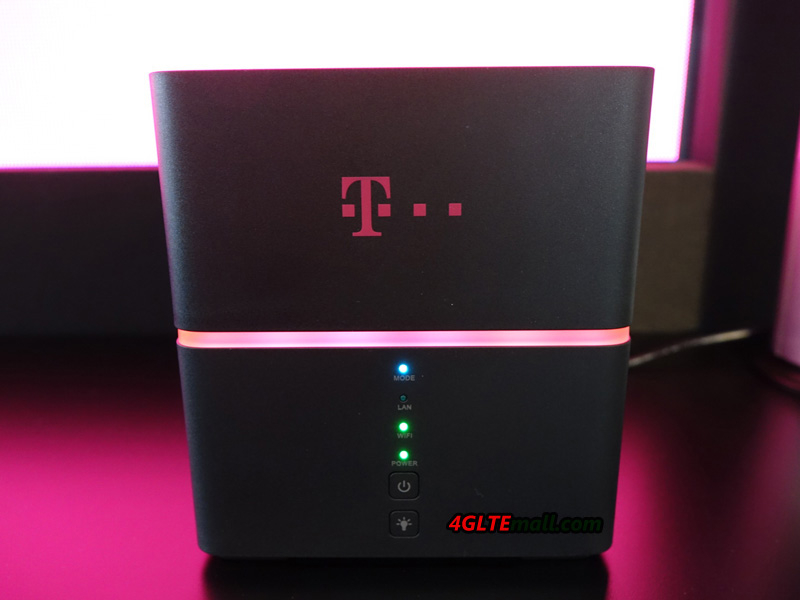
The appearance of HomeNet Box looks cool in black color, just like its predecessor Huawei E5180 Cube and E5170 cube. The design and functions are very similar to Huawei E5170, but the HomeNet Box is with high specifications. The Huawei E5170 can be divided to two parts but Huawei B529s-23a HomeNet Box is a whole part and can’t be divided.
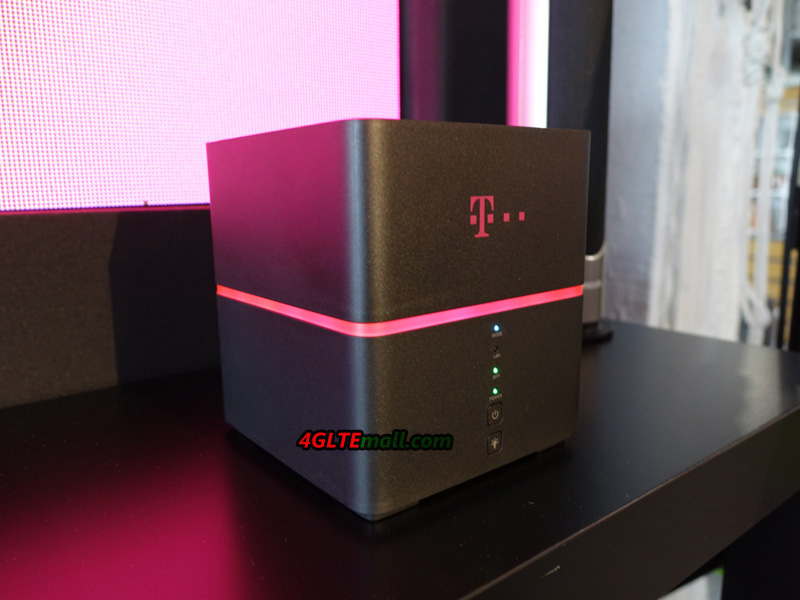
The Huawei B529s-23a router is equipped with an RJ45 port for connection via a traditional LAN cable. The built-in battery of 3000mAh can make the Huawei B529 router work as as a mobile internet center for multiple devices at the same time. What’s more, there are two connectors for external antennas available in the body. The connectors are at the back of the device and above the Ethernet port. A small cap just covers the two connectors. The connector type is TS-9. To ensure the fastest possible data transfer, just open the cap and connect an external LTE antenna to the Huawei B529s-23a. We had tested one 4G LTE Indoor antenna for Huawei B529s-23a for users who lives at the areas of weak signal:
http://www.4gltemall.com/4g-antenna-two-ts-9-connector.html
The great advantage of the router is its appearance, which makes it suitable for modern interiors. LED illumination informs the user of the connection status. There are four indicators to tell the Mode, LAN, WiFi and Power status. Power button is just below the indicators. Like other Huawei LTE Routers, you can control all of your device functions with Huawei HiLink, available from the Google Play store. And you can also log into the web interface to configure the router per your preference such as DHCP Server, DNS RELAY and NAT, along with security services.
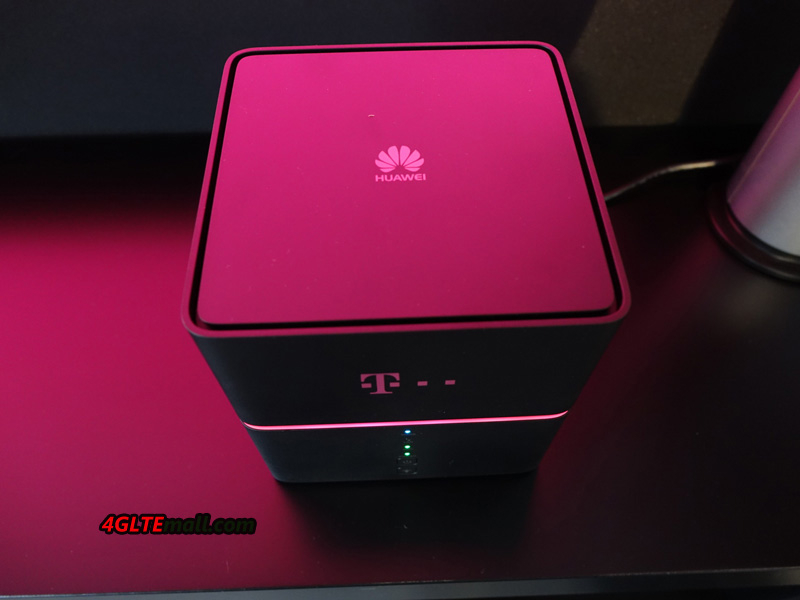
The Huawei B529s-23a router supports 4G LTE frequency bands B1/3/7/8/20/32/38. In addition, it is also backward with 3G UMTS and 2G GSM networks. With the support of LTE Cat.6, the Huawei B529s-23a delivers up to 300Mbit/s data rates and up to 50Mbit/s data rates. At the same time, up to 32 devices can connect with the B529s-23 router for surfing. The HomeNet Box uses Micro SIM card, if you get a NANO SIM, you’d better use it with an adapter. The latest WiFi standard 802.11 ac is available in the Huawei HomeNet Box on dual-band(2.4GHz and 5GHz).
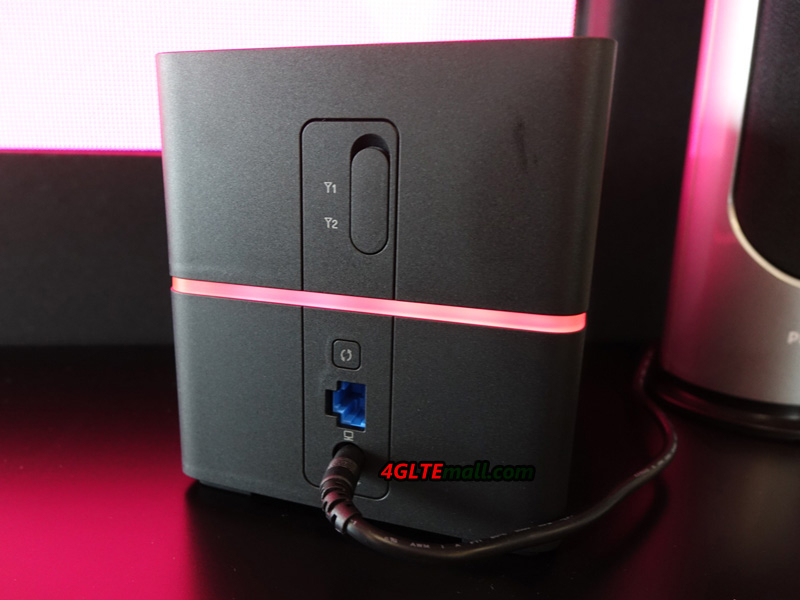
In conclusion, the Huawei B529s-23a is a cool router with powerful functions including the support of LTE Cat.6, built-in battery and latest WiFi features. Actually, with the development of LTE technology, more and more network providers upgraded their networks and of course to provide new devices to support higher networks. Here now, the Huawei B525 and Huawei B618 are latest routers with similar or higher specifications. If you want to know more LTE devices, you may follow us.
